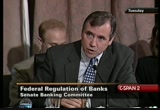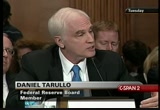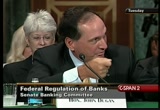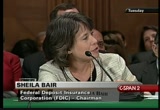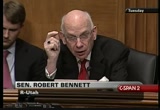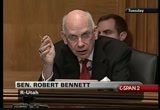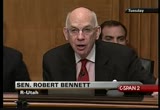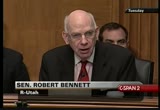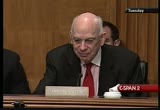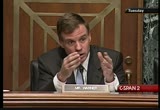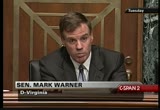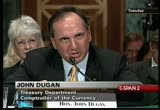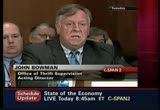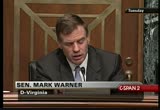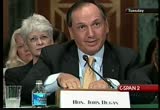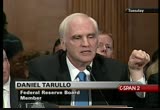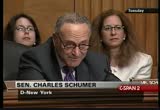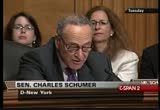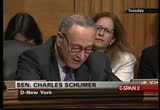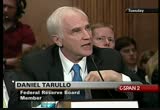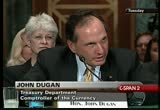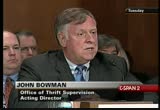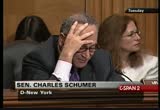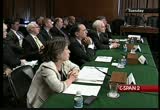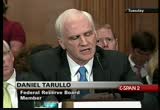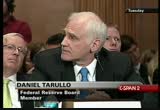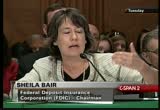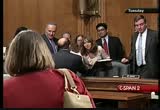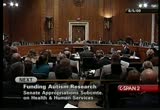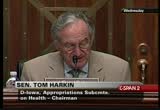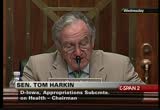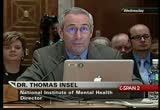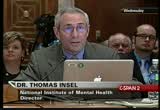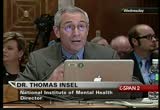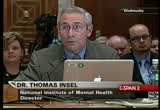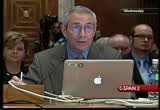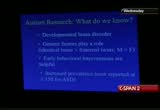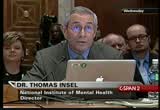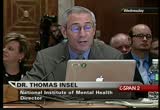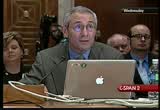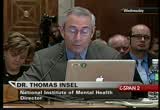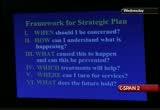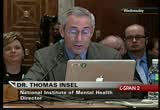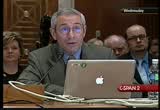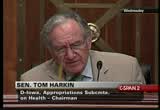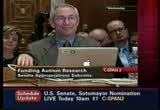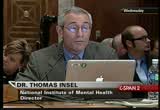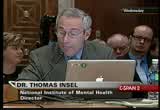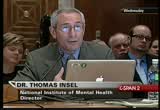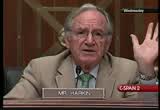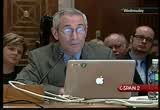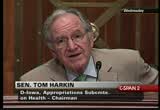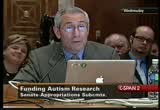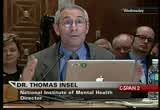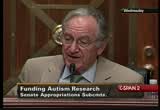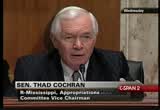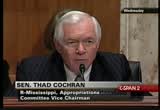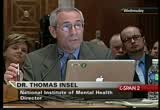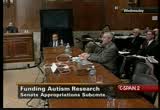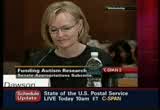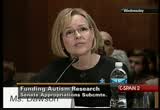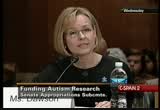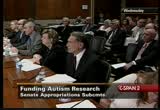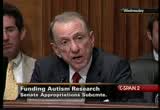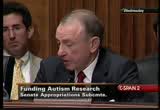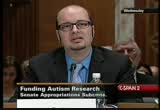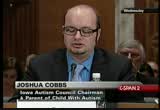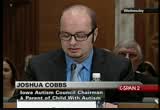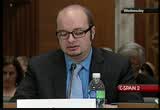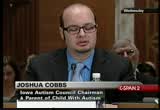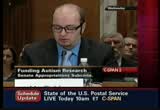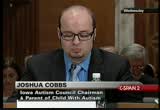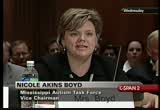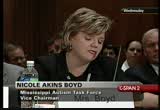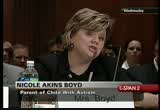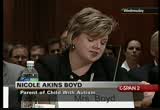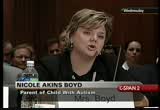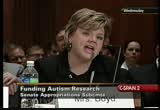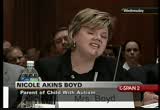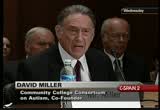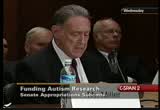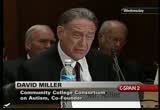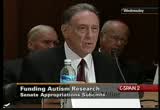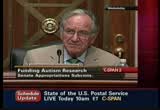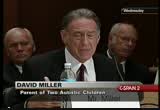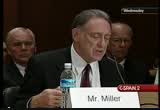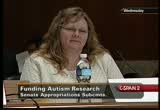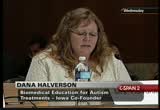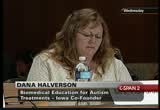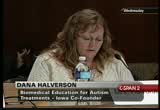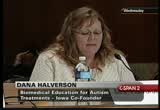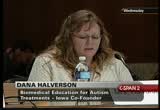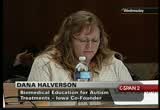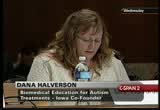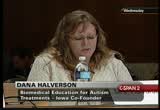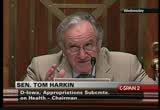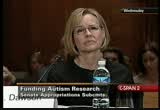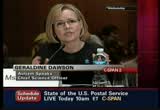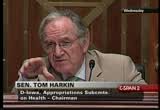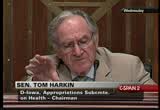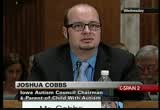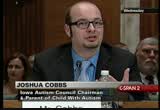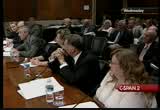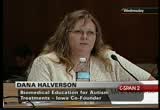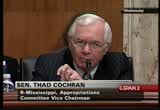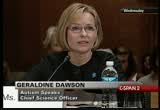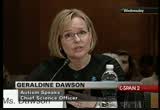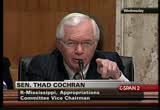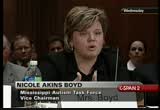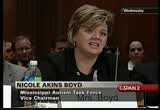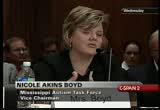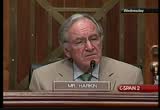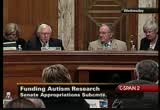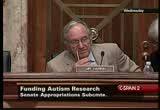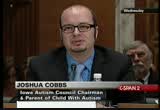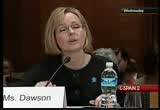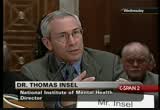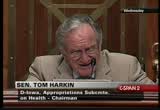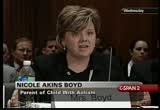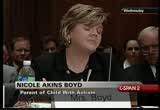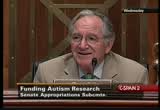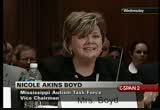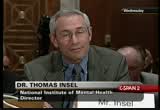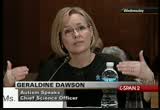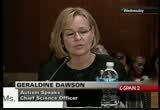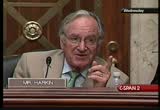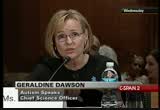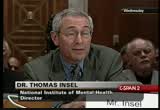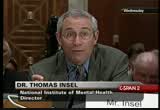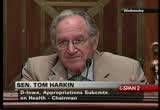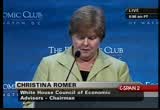tv Today in Washington CSPAN August 6, 2009 6:00am-9:00am EDT
6:00 am
6:01 am
applicable capital requirements, or bundling things in one form and moving them around the entity, and that part of what needs to be done is to take regulatory steps that minimize those opportunities. the senator was asking earlier about -- senator vitter was asking earlier about bringing off balance sheet assets back on to the balance sheet. that is one way to combat regulatory arbitrage. >> do you think would make more sense to have a holding companies and the banks under the same regulatory agency? >> i don't, actually. with respect to small holding companies, particularly those that have only a bank -- it is basically a shell, and there was a bank, no other entities -- by now the additional holding company supervision is quite modest.
6:02 am
as the bank holding company picks up additional activities, if it does any of its own capital raising, if it has even a small additional subsidiary, if it does management from the holding company level, that is when an independent scrutiny of those activities seems a valuable. as you get to a bigger institution, even more complex institution, it seems that the task becomes more specialized, because you are looking not just at immediate impact on the bank, although that is important, because we are protecting the deposit insurance fund, but you are now also needing to examine how the whole entity is creating, can be creating risk in an of itself, and that involves different kinds of activities, different kinds of regulated entities that are, as you say, moving things back and forth or acting in parallel, and
6:03 am
that is where i think you do need a different approach which looks at the holding company as an integrated whole, supplementing, complementing the rigorous functional regulation that takes place in the subsidiaries. >> yes, please be very quick, and i will get my second question. >> i do think there are times where there are activities in the bank and holding company that there are some types of activities but subject to due to different levels of supervision and we ought to fix that. >> we have suggested in prior testimony large institutions have their own resolution plans so that they could be acquitted quickly if they got into trouble, at a creek -- and a key to this is separateness of what is in the bank. resolution is very complicated with these large institutions because of the interrelationships between the bank, and it is hard to tell the
6:04 am
difference. we also, in terms of -- there is a provision called 23a which is designed to restrict banks holding strings for the holding company. we have increased pressure to agree to -- the fed has the authority to approve these requests to move more higher risk assets into banks where they are funded with insured deposits. in terms of the incremental step, we would very much like to have a statutory role in that 23a approval process. >> i want to get senator bennett in before the vote. senator bennett. >> probably given the time, this will be more of a statement that you can ponder that question that i want answers to. but i would like to get some answers later on.
6:05 am
it will come as no surprise that i want to talk about ifc -- ilc. no one has discussed the ioc charter in their written testimony. the growth of ilc's has been one of the great successes in financial services markets. they are the best capitalized and safest banks in the country. they were in no part a contributor to the financial crisis. they provide credit in places where it has not been available for comment niche markets, a diverse set of products, and the administration's proposal says to eliminate them. i find that incredible. we talk about lehman brothers, cit, all had ilc's and as they
6:06 am
wound down, those with assets that were the crown jewels. the ilc's had the most value. and yet the proposal is to eliminate them and eliminate the charter. you made a comment that the center of this crisis is too big to fail, and much of the discussion has been in that area of two big to fail. may i respectfully suggest that the center of the crisis is not too big to fail. too big to fail as a manifestation that came out of the center of the crisis, and to put it in very much layman's terms, the center -- the crisis was caused because of a game of musical chairs with respect to risk. and we build more and more risk into the system because while
6:07 am
the music was playing, more and more institutions past the risk on to somebody else, thinking, to use the phrase that sheila used, "i have no skin in this game any more." of the skin being this particular instrument. it starts with the borrower. he has no risk whatsoever. there is no equity in the house. he is getting 100% of loan. sometimes it is a liar alone. the broker who arranges the loan has no risk in the game, because he passes it on to the lender. the lender has no risk in the game because he passes it on to the gse. the tse has no risk, because with the rating agency that has no risk, it has rated it, and he can pass it on and securitized it to somebody else. at every step of the way, somebody makes money -- on a
6:08 am
fee, a commission, whatever it might be. and when the music stops, it turns out that everybody at risk in the game, because the whole thing collapses. i would like to know a regulator that can focus on that question, not how big you are, but where are you in this chain of musical passing on of risk, musical chairs, if you will? no more loans in the beginning. no more liar loans. brokers, you have to have some kind of risk if you get involved in brokering this loan, so that you will then, by market pressure, do your job better to see to it that you do not pass a bond with the letter maintains some kind of risk as the chain goes forward. the gse maintains some credit
6:09 am
risk. the rating agencies, he will -- the rating agencies, you will get a risk. nobody had a risk, and the bubble grew and grew and grew, because everybody was making money with no exposure. that is the problem that i want to solve with this restructuring rather than working around some of the turf battles that we have talked about. i will now go save the republic and you can respond -- [laughter] to chairman warner. >> anybody want to respond? >> i will just say a word, since this will be recorded. i actually agree with everything senator bennett said except that i think too big to fail played exactly into the narrative that he gave us, because when he was talking about the the gse's, some of the
6:10 am
biggest institutions of all, regarded too big to fail, it was at the gse's is not the only problem, but it is a very important problem. i should be careful about speaking for people on the panel, but with respect to things like making sure that risks are properly assessed by entities, and making sure that compensation systems in entities accurately reflect the risk and that employees are assuming, are important pieces of a reform package. >> i would say, speaking for myself, i would agree that, as i said, the ability to choose a state charter, a federal charter, we don't think is a driver or contributor to this process. we are not aware that the administration is going to propose that. speaking for myself, i do not see that they were in any significant way involved with what was going on. >> let me go ahead and ask my questions, and then i will call
6:11 am
on senator schumer. spank you, senator schumer. -- thank you, senator schumer. i want to go back to where chairman dodd started. this question of a single regulatory depository read a letter. some of you raised legitimate concerns. i know that folks on the second panel will perhaps have a different view. paul volcker has a different view. past chairs of had a different view. your point was valid, how you make sure you don't infringe on the insurance function. i think you can achieve that i have a backup authority and going in and checking those institutions, your ongoing role as an insurer and what senator corker and i have talked about, and expanded resolution authority. i also tend to think that the notion of an enhanced system at
6:12 am
-- enhanced systemic risk council the would include the fed and treasury and the fdic and others would give you the ability to have those variety of voices heard and i would also just raise one other point, that we have talked in a lot -- talked a lot about the truck during -- the chartering and the ability to change charters, and that beyond that, you have raised a proper questions. each of you have a licensing division. there is a question of the selection of a charter when you are starting an institution. i guess my first question would be having that very nature of the taurus at the beginning, not switching midstream, but the selection toys at the beginning, -- choice at the beginning, doesn't that create
6:13 am
regulatory arbitrage? doesn't that create the arbitrage issue? >> first, senator, sheila and i don't have any authority to trucker institutions. the banks we supervise are state-chartered. i would say, though, and she can respond to this better than i, but i would say that because we have a similar regulatory requirements -- >> if he could do it fairly quickly -- >> similar requirements for all institutions, and the fdic has to decide whether to grant insurance to each depository institution, no matter wants to be in short -- to be in short -- there is a way to contain that kind of arbitrage all permitting a useful kinds that states engaged in.
6:14 am
>> i would agree that we have a licensing function, and i would say that just because you have a choice when you begin operating, not necessarily arbitrage. there are differences with the charters and what they can do and how they can do it. some prefer to have a local, state government regulation, even though we have a local examiners on the ground there. the fdic does grand deposit insurance to all of them. it has been after they have been in operation, where someone is facing a problem and they seek to change the charter to avoid a downgrade or enforcement action and move to a different charter. that is what troubles all of us a great deal. >> in terms of choosing the charter at the outset, the thrift charter is unique in terms of the kinds of business that an entity would want to engage in. people choose a charter based on the business plan.
6:15 am
6:16 am
arms around this non-bank financial arena? clearly, what approach the administration has talked about is on the consumer and, specific financial products, coming from this array of institutions. another is if they kind of bomb up to the love all of -- bump up to the level of becoming systemically risky, the fed would have oversight. what i am not clear on is should these non-bank financial sector have some level of dated a prudential regulation? i have not seen anybody propose , one, is it needed, and two, whether that day-to-day prudential regulation, in terms of safety and soundness, would land? >> i think you have a day-to-day separation because -- with the
6:17 am
non-banks, you do not have that. >> should they have some? >> i think, actually -- no, i don't think you need to go that far. i think the consumer abuses for the small entities for more of a significant driver, the lax underwriting, which then spilled over to the large institutions because of the credit situation that they created. but no, i don't think they do. if you have the ability to post credential requirements for systemic institutions or systemic practices, you don't need institutional -- >> the council for systemic and the consumer down here? >> i generally think it is a daunting challenge for the tens of hundreds of thousands of different financial providers to regulate them all around the safety and soundness, but i think the administration would do so and have the authority to do so for consumer protection. it does not get at what is a
6:18 am
fundamental issue, the extent they engage in very bank-like function, and there is a safety and soundness issues like an underwriting standard, down payment requirements. that is not really a consumer protection thing in the traditional sense. >> it goes to the, that senator bennett was making of making sure you have skin in the game. >> but part of the mortgage legislation that passed the house last year at, and standards that i would say were prudential standards that apply. that would be helpful for mortgage providers, but not necessarily all financial providers. there may be some instances where some of that is warranted. >> but what did senator bennett's approach that you originated a product and keep it in their -- it would put some requirements of safety and soundness on the institution?
6:19 am
>> absolutely. >> i do think that the question of where regulation stops, how broadly the perimeter is cast, is an important one going forward. we know that we will not have the same problems we had a few years ago. if it will be new problems. -- it will be new problems. i thought that one of the important roles of the council, some kind of interagency council, is precisely to that i tend to issues that don't seem under anybody's regulatory umbrella at that moment. >> beyond just being whether there is systemically risky -- >> i think you pointed out the problem. you have systemically risky institutions addressed, and regulated institutions already regulated that are addressed, and then you have consumer. but even if you have a practice that is troublesome, there ought
6:20 am
to be a mechanism for somebody making an evaluation of that practice, and if the council saw that if one of its members had authority to regulate, it could suggest it. the congress to think about giving some kind of the fall of backup authority to the council in the van -- >> very quickly, because the senator from new york is anxious -- >> the ability to regulate or oversee this group between the council and the cfpi. whatever scheme is brought up for past legislation, there are very creative people will look at that and they will find a way to get around it. whether it is at the state level or federal level or what ever else. people have a business model and they want to engage in a particular activity, and the preference is to engage in that activity with the minimum regulation. it is a difficult issue.
6:21 am
>> i want to thank you all for being here. we have gathered here with one common goal, to make our financial regulatory system is strong enough to prevent another severe financial crisis from happening. i've read the written testimony. if i were in your shoes, i would make the same arguments. but some would argue that there is a bit of turf protection here. that is natural, but should not be the dominant consideration as we move forward. .
6:22 am
>> there is more discussion in the systemic risk regulator. there is a good argument the insurer should be separate from the regulator because they are different concerns. so let me ask you this -- here are four arguments for a consolidated regulator -- first, a consolidator regulator would prevent charter shopping site bank cannot take its own charter and regulator. countrywide did that. remember that, mr. bowman? a hodgepodge of regulators as a
6:23 am
conflict and create confusing burdens for the banks. we have heard from banks or told one thing by one regulator and another from another regulator, each of them had authority. third, a secret -- a single regulator could keep a track of dangers and development. fourth, a single, consolidated regular could eliminate arbitrage and gaps. no bank could escape from being held accountable for violations of poor practices. my question to you is do you disagree one consolidated regulator would avoid these problems or have these four benefits even if you think other mechanisms might be better for the reasons? who wants to go first? >> i will start. i would say each of the four things you mentioned is an important thing.
6:24 am
some of them, like avoiding charter conversion arbitrage can be avoided short of a single regulator. that's one thing we have tried to do already. the only thing i would add to what you say is that there are costs to going single regulator route. one of the costs is that the fed loses some insight into how banks are functioning, how they are moving money and why the volatility of money is what it is. another potential cost is you have a single, all encompassing regulator and sometimes it loses perspective because it is the only game in town. >> i know the arguments on the other side, but you agree that these four arguments make some sense. >> i think a couple of them are strong. >> i would agree.
6:25 am
those benefits are there and real and this is the right equation. you have to ask what are the costs. there are certain things the federal reserve brings to the table in terms of closeness to the markets and expertise from the open market operators that would be difficult but not impossible to regulate, but that are real. second, as i mentioned earlier, it is hard to be good at it is it you -- it is hard to be good at it if you are not doing it all the time. >> i would just say that i think on the monitoring, if you look at the single regulator, they really were not any better. if you have a single monopoly regulator, that contributes to regulatory lax -- that regulatory laxity. it's not just a matter of picking bank charters, if you don't include securities common for of the graves dealers, and
6:26 am
others, you still can't use a legal model that would fall outside of this. unless you put everybody out of this, you'll still have some degree of arbitrage. >> i would agree the single form of regulator has not proven to be any more effective in terms of what we have now. i would also be remiss if i did not point out that since 2008, 79 financial institutions have failed. 50 national banks and 11 thrifts. i also need to point out that of t.s. and charter countrywide, -- ots and countrywide, countrywide was sold to bank of america. the ability we had to affect countrywide in that time was very limited. >> i have another question. this relates to the point mr. bowman just made.
6:27 am
as you said, 54 of the 69 banks that failed this year are state- chartered banks. i guess it is a historical anomaly why the fed supervises state chartered banks and mr. dugan supervises federally chartered banks -- when i first get to the banking committee in 1981, i didn't understand it. it just happened. let me ask mr. tarullo , most of the failed banks were not regulated by the supervisor or by ots. explain to me and this bair can answer as well. explain to me why the fdic and the fed should keep state- chartered supervision, particularly if we're giving the fed more responsibilities and
6:28 am
other areas. if you think those functions should be kept apart, from the proposed national bank supervisor, why shouldn't at the very least merge fdic and the fed supervision of this state chartered bank? >> can i ask the panel to try to answer quickly? >> i will ask unanimous consent that each panelist be asked to answer the question in writing. i did not realize we had a second panel and i was the last one here. thank you. >> it looks like we're going to have to reschedule the second
6:29 am
panel, so i'm anxious for you to respond to the senator's question. >> mr. chairman, i am deeply grateful. >> the national banks would be chartered by the -- would be supervised by the otc as a loss charter. members of the federal reserve system and would be supervised by federal supervisors by the fed and of their non-member banks, their fight -- their primary regulator would be the fdic. there are two answers to the question. one is that you suggest history. the controller was started in 1863 to create a new national charter which had a dual banking system ever since. i think chris unconcern on the part of state banking commissioner's that -- i think there is concern on the part of the state banking commission that they have had as their overseer of the federal level, the same entity that charters
6:30 am
national banks. >> that is what we call in brooklyn tight. >> unquestioned. but the concern is whether or not there be the same treatment of national and state-chartered institutions. second, are their gains from having the fdic and the fed supervising banks as well as performing other functions? i would suggest that the arts. >> -- i would suggest that there are. >> there are a lot more state chartered banks, so lot of these are very small institutions. >> a lot of the biggest failures were not under mr. bowman, but his predecessors watch. >> we have provided support for larger institutions and i think it needs to be taken into account. i know it is confusing that we have these multiple regulators
6:31 am
and it's frustrating because it's hard to explain to the public. on the other hand, as a deposit insurer, we find helpful to have bank -- that people in banks all the time. it gives us a window into what is happening and what emerging risks that might be. we could perhaps fix it up through a back up supervisory process, but if we were going to shift to that model, we would have to be must -- we would have been much more robust. with have to keep this data points continually into the risk assessments. that would add to the regulatory burden. supervisor perspective that we give that to state charters banks is useful to that function. >> if i could add to the confusion, the ots is the backup regulator for the state chartered associations. so you have a federal regulator at the state level. >> i would like to thank the panel for a very interesting
6:32 am
morning and one that has been very helpful. i want to apologize to the next panel. i understand staff will be back to about rescheduling. we want to hear your views and a dozen of the views from the second panel were perhaps more sympathetic to the single depository regulator and we want to get those views on the record and get a chance to ask questions. thank you very much to the first panel and we will reschedule the second. the hearing is adjourned. out of every 150
6:36 am
children born this year will be diagnosed with autism. among boys, the rate is even higher. we do not know what causes this disorder. most researchers agree that every discovery seems to raise more questions even though autism has not just one of genetic prospect but many. we still do not know with the turning mechanisms are. many experts think environmental factors may be a play. we do not know what they are exactly or whether they take effect during a child's first few months or years or maybe during gestation. we know a little bit more about interventions. some behavioral interventions in to help. we are nowhere near a cure all. this subcommittee has taken a
6:37 am
strong interest in recent years. the fiscal year 2010 appropriations bill that was approved by the committee last week include a range of activities related to what some such as outreach and education, surveillance, medical research, and the inter agency autism coordinating committee. it also includes $40 million for a new program to help students with intellectual disabilities make the transition to colleges and complete their post secondary education. another problem is how to address the growing adult population with autism.
6:38 am
i want to thank all the witnesses for coming here today. i will leave the record open for his introductory statement. we have two panels. the first is the director of the mih. akins boyd is from mississippi. david miller, va.. ms. dana however some from iowa. i think we covered all the aspects of you want to cover on autism on these two panels. first we will open up.
6:39 am
as with all of the people testifying this morning, your statements will be made a part of the record in its entirety. we will ask you to go ahead and proceed as you so desire. >> i am honored to be here the other panelists. i know this is a very busy time for you and your colleagues. we appreciate your taking time here in the middle of the summer to hear about the latest research and the latest challenges with autism. the brief is to get you -- you a quick update on the research as we last met which is a little more than two years ago. this has been an extraordinary. with a lot of exciting progress. we are going to try to review the. the testimony i hope will be submitted to the record.
6:40 am
rather than reading that, i thought i would take you very quickly through three questions. what we know at this time? what we need? what do we doing? we will try to summarize this very quickly. today you on track here, let me make sure we are all on the same page. autism by definition start by age three. we are talking about three different kinds of symptoms that characterize autism, reduce social behavior, abnormal language, and repetitive restrictive behavior's that often are called steer at peace. these are the definitions that many children come in with additional complicated features. i listed a few of them here. 20-30% will have associated seizure disorder that can be part of the autism syndrome. intellectual disability in various sorts.
6:41 am
we have many families were concerned about gastrointestinal problems of many different kinds. about 10% of children who have an autism label have odd faces or appearances, we call this is more thick. somewhere between 10% and 20% have regression. everybody may regress to some degree. some seem to develop quite well for 18 months and then will lose language and function. the results of understanding these complicated features and the fact that this is such a heterogeneous syndrome is that we increasingly talk about all systems. there are many -- autisms. sometimes we are prisoner of our own language by thinking of it in the singular term. the term has been most widely
6:42 am
accepted, the autism spectrum. all that means is that we are talking about a range with in the syndrome from those children who really have very limited functions and very little -- very really have limited language or severe debilities and they should no interest in social interaction. there are lots of motor after nemeses like hand flapping. they are the ones often have these distorted features. at the other end of the spectrum are children who are going to graves to be often highly successful. they may have social awkwardness or be called nerdy or more interested in numbers, but they may be tremendously useful and successful and made huge contributions. these will be areas that will
6:43 am
allow them to use their oxygen to its best, which is the ball mechanical and numerical and less social aspects of the world. all of those people -- let's dive into what do we actually know what we have learned. i think there is wide recognition that this is a developmental brain disorder. we do not know yet where in the brain or what in the brain or went in the brain things go off track. the most recent research would suggest that what we are talking about here is not a specific region, but it may be more likely a problem of brain
6:44 am
connections. that may be very diffuse. it is quite possible that the reason you see problems in language and social interaction is that those are functions that require the greatest numbers.. secure connections are not working, he can see deficits in those kinds of functions. there is been -- the greatest degree of progress has been internet. that is true in almost every area of the date has been genet is. that has been true in almost every area of science. -- the greatest degree of progress has been in genetics. that has been true in almost every area of science. two years ago when i spoke to you, i talked about how it will be important.
6:45 am
we would have said that it was important because we know a couple@@@@@@@ @ @ @ @ @ @ @ @ @r contribute. where two years ago and may have said 5% of any population of children with autism would have won in the syndromes, i think now we can say that number is 1 to be considerably -- adding now we can see that number is going to be considerably higher. there are new reports out about where mutations that may explain
6:46 am
another 1% or 2%. there is clearly a genetic factor at work here. it does not explain all of autism. we still need to learn a lot more about how genes and environments interact. there will be more research about that in the future. that is an important area of progress. we spoke about this two years ago. as you said in your opening remarks, interventions are helpful. they are helpful when started earlier. the one to find this, because i think the issue here is making sure the best behavior of interventions are available to people who need them. we are not talking about children but also children transitioning into adult and adults themselves. these to work but they are not always available or paid for. we didn't have a conversation later about how that is going to happen.
6:47 am
-- we do need to have a conversation later about how that is going to happen. we are sitting in a bar for how far these behavioral interventions will go it done early. the issue that you broke up -- brought of the opening remarks is one that is of great concern to you is the increase in problems. the centers for disease control and prevention now reports from 2007, a rate of 150 children being given a diagnosis. something on the autism spectrum, i do not think that number is a great variance of numbers we have seen elsewhere. it is also true that is about a tenfold increase over the numbers coming from the cdc. the increase is of great
6:48 am
interest to many of us. i want to caution you that a change of prevalence is not unique to autism. we have seen a 40 fold increase in the prevalence of pediatric bipolar disorder. we have seen a tenfold or greater increase in detention -- and attention deficit hyperactivity disorder. this kind of a change is not unique to autism. it is certainly one that deserves our attention. we have to remember the difference between prevalence, which can be diagnosed by change in diagnoses, that could be a crew increase in the instances. that is an area that requires more research. that is what we know, what we need? part of what we need is filling in the gaps of what we do not know in taking you through the kinds of things we are talking
6:49 am
about and understand more about the risk architecture of the whole spectrum. genes are important. environmental factors are important. most important will be how they interact. that is not unique for autism. that is true for autism -- for asthma, etc. new therapies and began to emerge. we want to understand this. the point is to be able to develop ways of protecting this disorder -- detecting this disorder much order. brain disorder behavior is one of the last features to change. that is true for alzheimer's, parkinson's, huntington's, and it will be imported to move upstream by having a biomarker allow us to detect risk in disorders much early. we want to have interventions such a more effective.
6:50 am
behavioral interventions are fitted for many children but they are expensive, expensive -- extensive, and take a long time to work. we want to offer more than behavioral interventions. we want to know what he meant to work best for what people. you'll hear a lot about personalize medicine. we are hoping that the new director will be confirmed by the full senate this week. should that be the case, i think you will hear from him that there is a high priority. impersonalized money. -- there is a high priority put on personalize medicine. as you mentioned in your opening remarks, we have a whole wave of children of what is in that will soon be adults with autism. how we make sure that they have the access to services that we take care of this transition and
6:51 am
the coverage deserves urgent attention from this committee and from others who make policy. luscious a little bit about what we are doing. i will tell you -- let's just talk a little bit about what we are doing. i will tell you that we are working with the coordinating committee. . . >> would happen soon thereafter with the american recovery in reinvestment act was the
6:52 am
opportunity to make new investments to jumpstart the strategic plan, focusing on the short term objectives. we hope within the next six weeks to be able to announce publicly the large number of grants that have been funded through the american recovery and reinvestment act, including not only the special rfa to support new cotton is a research to the tune of $60 million, but also a large number of challenge grants and grant opportunity warrants that will be made and will be announced before september 30 of this year. finally, i will just mention that we have also tried to jumpstart much of this progress by creating a national database for autism research which will be essentially a meeting ground for scientists around the world to share data and share the tools necessary to accelerate progress in this area.
6:53 am
as you will see in this plan, there were six questions that guided the effort to help us think about what were the most important issues. it includes both public members and federal members. these efforts came out of a rich discussion about what is that families and people on the autism spectrum most are looking for. we have taken each of these too hard and come up with a summary of what we know and what we need for each of the six questions. we have short-term and long-term objectives that are being addressed through the recovery act and other sources of funding. i will finish with this vision statement which i thought would be worth while steering with you -- sharing with you.
6:54 am
that is to inspire research that will profoundly improve the health and well-being of every person on the spectrum across the life span. i cannot emphasize enough the importance of now attention to adults and soon to become adults with optimism. -- with autism. >> this plan will not only provide the road map for research but also set the standard for public-private cooperation and engaging the broad community who will be so invested in trying to make sure we expedite research progress. with that, i will make one final comment. and now you have been thanked for many things you have done, both for autism and for nih and many of the other issues to deal with. i would like to send a personal thank you for giving us allen murray, who will be joining hhs very soon. -- ellen murray.
6:55 am
for those of us ofhhs, is a terrific gift. we are delighted that you saw to it to share her expertise with us, so thank you, sir. >> thank you very much, dr. isel. >> i am pleased to join you at this hearing to thank our witnesses who have come to share with us their experience and talk about what we can do to more effectively deal with the challenge of autism. we have had hearings before, but it is important for us to continue our efforts to stay up- to-date and join forces with the victims and their families to help make sure we triumph and did not like the victims and their families down. we want to support the calls. thank you for being here to lead it off. >> thank you again for your leadership. on the interagency coordinating committee, just looking at the
6:56 am
list of people on the committee, as you know, our interest obviously is in research and finding causes, which hopefully will lead to prevention. also, we are interested in the early intervention programs and how you get to these kids early. do you have enough expertise on this panel in terms of, or you are looking at that aspect also? water the most effective early intervention programs -- what are the most effective early in a region programs we can find and work on? >> do we have the expertise? we bring in the expertise. each year we have to update the plan, and we do that by bringing in the experts in all the areas we are concerned with. we have heard about both ends of the spectrum, early detection and early intervention. as one of the places that needs a big push, the other end is
6:57 am
adults on the spectrum who need a lot more in the way of interventions. >> which treatments and interventions will help? your group is actively out there looking at different interventions and trying to find out which ones work best, and all our -- are you also promoting -- or you instigating different types of early interventions to track them and see which ones work the best? >> let me just go through the process very quickly. the first thing we did was to do a portfolio analysis. this was unprecedented. in the questions of interventions or any other aspects of those six questions, we asked all the federal
6:58 am
players, including the department of defense, but also the private groups which are very substantial players for autism. they are putting in significant amounts of research dollars. for the first time, everybody had shared their information about every grant a fund, how much they are putting into it. we were able to use that to map on to these six questions and see what is missing. one place where it looked like we were under invested across the sixth question is this area of interventions. how we feel that in? the first thing we do is bring the experts, at least on an annual basis, to tell us not only with the needs are, but what are the opportunities? what is really hot right now in terms of techniques, or things going on in other areas of medicine? the meeting this year will be on september 30 and october 1. we did a previous one which would have been in january of
6:59 am
2008, if i have that right. we used four days to hear from a broad panel of experts. i might add that is not only your typical academic grantee that we are hearing from. we are bringing in family members who may have had a very interesting experience that they think we should hear about. we are bringing in conditions as well who may be trying things we do not know much about yet. -- bringing in clinicians. we are making sure we get all the best ideas on the table before we decide what to recommend for nih and others to be looking at for funding. >> we are talking about applied behavior therapy. it seems to be successful. how early an age can you start that, and do we know what age
7:00 am
you should start that? >> i am going to duck that question, because the world's expert, dr. dawson, is sitting right behind me. she has just completed the landmark sdm4daá@ @ @ no question from the community that there are internal factors at work, and that some aspect of the environment is going to be interacting with genetics to make children and maybe even
7:01 am
unborn children vulnerable. it may be that these are prenatal internal factors. the only factor that has been explored in great detail would be vaccines. part of that has to do with an increasing number of vaccines. it has gone up over the past 30 years or so. i have made a slight so you can see what that looks like. there has been an extract -- a striking increase from 1900 until about 2009. there are more vaccines now in the recommended schedule. there are more injections that are possible currently. it is also important to realize that while the number of vaccines have increased, the quality of vaccines has really changed in the same time. if you look at the number of antigens that go into these
7:02 am
vaccines, although it does not show it here, the amount of protein that goes into any -- into the full group of vaccines that children are receiving >> so the vaccines are far more refined, far more targeted. they look very different than they would have even in when your children would have been vaccinated in the 1970s and before. so it's not quite comparing apples and apples when you look at this change over time. the one -- the research that has been focused on vaccines as a potential association with autism has been epidemiological research. and up until this point in time i believe there have been a total of about 16 studies involving hundreds of thousands of children, literally hundreds and thousands of children. and there is no evidence at this point of any association between vaccines, the number of vaccines, the kind of vaccine, any of the things we are showing
7:03 am
here, any increase or particular vulnerability to autism. >> i just want to understand, that what you just said is how you can have a study involving hundreds of thousands of children and the number of vaccines because they are all getting the same number before the age of two. if you go back to your chart, dr. insel, i have a little bit different chart. i have one from the center of disease control and prevention that shows that in 1983 the maximum number of vaccine doses administered before age two was eight. in 2009, its minimum of 21, maximum of 29. and from everything i can ascertain, it's more closely to join nine. so we've gone from eight in 1983, to 29 this year before the age of two.
7:04 am
so most pediatricians do that. so how would you ever find a group of kids who don't get those? >> i want to again remind you it's not comparing, they are not the same as 29. you look at the number of antigens that were present in 1983 versus what's present in the vaccines that a child would receive in 2000 or 2008. and there is the striking, striking decrease. this is not -- these are not the same formulations. they are not the same kind of vaccines. what we are talking about today, while the numbers have gone up, is a profound reduction, a profound reduction in the amount of rotini. >> some of these vaccines worked around in 1980. we've got a number of them here like pneumococcal, we've got influential, some of these weren't even around, hepatitis a. they weren't around in 1980. >> right. and the vaccines that were
7:05 am
around in 1980, has been changed in many cases. they are far more -- >> that we are using no. >> are not the same vaccines in many cases. >> are the same? >> they are not the same. they may have the same thing but the formulation has been greatly refined and that's a you get these kinds of changes. >> i get confused when we get in this area because i just want to focus on the number of vaccines, and the fact that they are all put together a lot of times before the age of two. i'm not talking about the number of antigens or anything like that, just the total number has gone up. and i don't know of any studies, and you may know some that i don't know about, any studies that would compare a cohort of children from zero to 82 that did not get the shots, and the incidence of autism and those that did receive 29 vaccines and did come down with autism. so i don't know of any study out could have done this.
7:06 am
>> we had a discussion with an the iac see just with this issue about could we the study of vaccinated versus unvaccinated children. we don't have the impact of vaccine expertise on that committee. and so we have decided to consult the national vaccine advisory committee, which is another federal advisory committee, that report to the secretary to get their expertise because they do have it. we met about a month ago to have this conversation with them. before meeting with them, we sent them the question saying has there been such a study, just the kind that you described. and if not, why not and could reduce such a study. and their first response back to us was first of all, it hasn't been done. they didn't think it was feasible to do it, but most of all they didn't think it was ethical. they had real concerns about the ethics of randomizing a group of children to not receiving vaccines. because they were particularly concerned about the risk
7:07 am
involved in not vaccinating a large number of children. and you would need a very large number of children for such a study. >> so we really can't tell that. but i do know, i know of people now with children who are not letting their children get those numbers of vaccines. some of these are highly educated professional people, and they have decided that they are not -- or they will stretch them out over a longer -- they will not get in before the age of two. maybe by the age of five or six. and so i know a lot of that is happening out there. and not a pediatricians i know will not treat a child if, in fact, they are not getting these immunizations that will tell the parents if you don't agree to them, the vaccination schedule, you cannot be a patient of mine. but i do know a lot of people that basically are not having their kids faxing. i don't know the ramifications of that. i don't advise that but i know
7:08 am
it is happening. >> but the problem is we don't know. we don't know if 29 vaccinations, immunizations by the age of two do have an effect. we don't know that. >> let me share with you the conversation we had on this committee, on the iac see because as you can imagine this is a topic that has come up. it is a highly charged topic. we hear not only from those people who are convinced that vaccines are the problem, those were convinced it is not. and i must say they are both ends of the spectrum here. but we also hear from lots of families who have had a child with autism and they are wondering what they should do about their next child. and that's often the question that is on the table because they don't know who to believe and what to listen to. >> right. >> the group of people who feel that there really is an issue here, and that we really ought to be concerned because there's a relationship when vaccines and
7:09 am
autism point to the numbers that you point to, blog entries, and they say yes there have been 16 studies and all 16 studies demonstrate no relationship. however, those are all epidemiological studies and you can't rule out the possibility that there's a very small signal their that might have been missed. on the other side of the coin, the other end of the spectrum, we are hearing from other people and not just scientists, but even family members on this committee who are saying enough already. if there's an environmental factor at play here we have spent a lot of money and time doing these sixteenths to studies and nothing has shown up on this question, maybe we don't need to turn that rock over a 17th time. let's move on and let's look at something that is more likely to shed light on what could be an important factor in increasing the prevalence, or increasing the risk for autism. so that's what we are hearing, and we are trying to balance both of those points of view.
7:10 am
and also trying to make sure that there is information available for people who are most concerned about what they should do with their next child. >> that is true, and that is, like i said, both the research on the causes and the triggers, but also intervention, early interventions and how we help people right now that are having a tough time dealing with children of their own right now. we've got to focus on the early interventions programs. and we'll get to that in the next panel. >> mr. chairman, thank you. i want to join you in welcoming doctor entry -- doctrine so. we have had efforts in the past to try to develop a body of information that will help us identify better ways of dealing with autism, what are the causes, are there other causes, what are the possible changes in
7:11 am
environment or nutrition, health care generally that we can turn to for help and deal with the challenges and the difficulties that autism brings to our society. i can recall back in mississippi joining with families there to help raise money, have benefit events, go on television, invite people to attend and contribute in the light. and some of the experiences that i had been observing the children who were victims of autism and talking with families, getting to know more about it really made a big impact on me and how challenging this situation really is. and so my heart goes out to those families who are dealing with it, and i just want to be here today to support the effort to identify how government can
7:12 am
be more helpful. what are the other possible causes for autism, what are the things that we can do. and to continue to work and not give up. a lot of people have invested a lot of time and effort, research, dollars, personal energies to cope with this situation. and i am curious to know from you, is there hope, have we discovered things, have we learned things over the last several years, have we embarked in this joint effort that give us any hope that we are making progress? >> absolutely. there is always hope, but there is even more than that right now. there is a very rapid progress. and i think this next period of time is even going to be more extraordinary because we are wrapping up the investments very rapidly. in 2008, our budget for autism research at nih went up
7:13 am
25 percent over 2007. in 2009, it will go up much, much more than that because we are saying this recovery act effort. and we have put money specifically into an autism request for application through the recovery act. i think the only disease specific such request in the recovery act from nih for this year. we've got lots of other things going with the template $4 billion, but this is the one that does have a disease name on it and because we realized that there is an urgent need, and equally important there is a tremendous opportunity right now for progress. we have the tools we need it we can really start to move quickly. we want to do that over the next two years. >> thank you very much for your efforts in being involved as a director of the institute of mental health. we appreciate you being here with us this morning and helping
7:14 am
us fully understand the challenges we have a head. >> thank you for your interest and support. >> thank you very much, dr. insel. we would like to call our second panel. i didn't talk to you earlier about this, but if you have the time to stay, i would appreciate that if you have to get back to the institute, i don't know, but if you can stay for a second panel i would appreciate that. >> i would be happy to stay, and that most of all want to hear the copanelists because i think all of us need to hear some of the personal experiences. >> why don't you just they appear? stay we are. you don't have to move. just they were ur. let's call the second panel, doctor geri dawson. let's start from left to right as i call them names. is your joshua cobbs, this nicole akin boyds, david millar and dana halverson.
7:15 am
>> thank you all for being here. some of you have come a great distance, and again, your statement will be made part of the record in their entirety. and you can kind of summarize five minutes or so, i would appreciate it very much. we will start from left to right here, dr. dawson. the chief science officer for autism speaks, prior to that position she was a professor of psychology and psychiatry at the university of washington, the founding director of the university's autism center, dr. dawson received her phd from the university of washington. dr. dawson, thank you very much, and please proceed. again, summarized in five to seven minutes we would appreciate it. >> good morning, mr. chairman. >> punch the button. >> good morning, mr. chairman. i want to thank you for inviting me. i am very honored to appear before this subcommittee. and i want to thank the committee members, and you, mr. chairman, for your leadership in providing full funding for the
7:16 am
combating autism act. and also for your most recent fiscal year 2010 appropriations bill. this year, more children will be diagnosed with autism, as you may know, then with aids, diabetes and cancer combined. autism research, however, is still significantly underfunded despite greater public and congressional awareness. for example, leukemia affects one in 25000 people, but receives research funding for $310 billion annually. pediatric aids affects one in a thousand children. its funding 255 million a year. autism, as you know, affects one in 150 individuals and yet nih funding for fiscal 2009 is estimated to be a hundred $22 million. as you have heard, most scientists agree that autism is
7:17 am
caused by accommodation of both genetic risk factors and environmental factors. and we discovered some of the autism risk genes, but we still know very little about the role of the environment and how it interacts with these genes. we have come to understand that autism is not one disease, but many different diseases that has many different causes, and each cause will likely only explain a minority of cases. so piece by piece we must discover each of these causes so that effective treatments and prevention will be possible. it will be necessary to invest in large-scale population -based studies that broadly examine genetic factors and environmental triggers, such as the nih national children's study. it will also be important to invest in large-scale databases and biorepositories such as a national database for autism research, the autism genetic
7:18 am
research exchange, and the autism tissue program. a recent study suggested that autism may be fundamentally a problem of the synapse, as you have heard from dr. insel, the connection between brain cells. some of the very best in earl scientists in the world are working hard at understanding how genetic mutations can change the way in which iran's communicates. and they are developing therapeutic strategies that might restore the function of the synapse. while this work is offering real hope, the pace of discovery is simply too slow in large part because of lack of adequate funding. we can now screen for autism at 18 months of age. and autism speaks is funding several clinical trials that are evaluating interventions for at-risk infants who are as young as 12 months of age. the hope is that by taking
7:19 am
autism early will be able to reduce its severity, or even prevent the syndrome of developing. however, the impact of this work will not be solved in less pediatricians are using the available screening methods, and parents have access to trained professionals who can deliver these interventions. that's why it is critical that we continue to study destination method, invest in training professionals and caretakers, and support federally mandated insurance coverage for behavioral interventions which we know are cost-effective in the long run. while behavioral interventions are effective for some individuals, most individuals with autism suffer without relief from the autism itself and a wide range of medical conditions such as sleep disorders, gastrointestinal problems and epilepsy. very few clinical trials have been conducted that address these medical conditions. and virtually no cost effectiveness studies have been
7:20 am
conducted to determine which treatments are most effective. parents are left to sort through confusing and often inadequate information about the various treatment options and claims. and clinicians are often at a loss and helping parents to make evidence -based treatment decisions. this gap in autism research must be addressed. very little research has been conducted today that addresses the issues that adults with autism face despite the fact that i don't care accounts for the both of the 35 billion that is spent annually on caring for individuals with autism in the united states. unlike other health conditions, we have limited information about autism health care utilization, barriers to access, health care disparities in the u.s. or cost effectiveness models. mr. chairman, over the past two years your subcommittee and you have been responding to the challenge of autism with resources. and this is the beginning of a
7:21 am
meaningful fight against this very challenging disorder. but more is needed. to better understand the disorder, to diagnose it, and to better treat those individuals who have it. so i want to end by thanking you for your time, for your commitment and for your leadership. and i am very happy to entertain any questions that you may have. >> thank you very much, dr. dawson. before we go on with the rest of the panel, and we will go each one and then we'll open it for questions. i want to recognize my good friend and colleague from pennsylvania with whom i am sure the gavel here over the last almost 20 years, but senator specter is a member of the judiciary committee, as you know, or on the floor with the sotomayor nomination so judiciary committee has to go to that and i will yield to senator specter. >> thank you, mr. chairman, for yielding. or taking up the confirmation hearing of judge sotomayor for supreme court, and i am due on
7:22 am
the floor shortly. but i wanted to thank you, mr. chairman, and ranking member cochran for scheduling this hearing on this very important subject, and thank the witnesses were coming in. autism is a heartbreaking ailment, and of the many issues we had to face, among the toughest, talking to parents who have children who suffer from autism. there's a real question of doing more. senator harkin and senator cochran and i have worked hard on funding for the national institute of health. and for a decade we were able to raise funding from 12 to $30 billion, a time when senator harkin and i have transferred the gavel. senator cochran was chairman of the full appropriations committee. and regrettably, that's not
7:23 am
enough. i note that funny for autism was slightly under $52 million in 2000, up to 122 million now, an estimated 2141. cdc is seeing an increase from a little over a million to a little over $22 million. we have been successful in getting into the stimulus package, $10 billion. and it is my projection that some of that will be going to autism. these funding levels are set by nih in order to avoid what we call politicization. our job is to get the money, but not to distribute it. and i think there ought to be a bigger share for autism, but we are pushing to make that happen.
7:24 am
and on comprehensive health care reform, which we are working on now, we are trying to get 10 billion added as a base of 30. start with 40, would give us a better opportunity to do more on this very, very important ailment. so i wanted to express those views today. and staff will be here to follow the testimony, we will have a chance to review it. appreciate you coming in. and you have our assurances we will do everything we can on this very important ballot he. thank you, mr. chairman. >> thank you, senator specter, and i are standing up to be on the floor for the nomination. and now we will go to mr. cobbs. mr. cobbs, if i were a member right, you are from ottawa up near sioux city. >> yes, sir. , i represent sioux city area. >> and you're the chairman of the i've autism council. the father of a nine year-old boy with autism, noah, i understand your wife is with
7:25 am
you. >> she is in the audience keymac okay. and two other children, even, 16 in sydney, eight. and you were here at our last hearing, would you a couple years ago? >> i was in the audience of the last hearing, and then have been involved in the telehealth project with a young boy, noah, right? >> yes. >> i'm interested in what's happened in the last couple of years. welcome to the committee, please proceed. >> thanks for having me. good morning, mr. chairman and members of this distant whoosh committee. my name is josh concert on the chairperson of the eye with autism council, and most importantly a parent of a child with autism. i spent over seven years trying to better the lives of individuals and families affected by autism. through insurance and education reforms. when i was last in front of this distinguished committee i spoke of the successful and cost efficient serves as my son received using telehealth
7:26 am
technology. these services are provided in my home in iowa from professionals in florida through the foundations as federally touted research project that we are one of 15 families that participated in this demonstration across the nation. in this model, after a brief phase of onsides face-to-face training, which is crucial to build a therapeutic relationship, we were linked to professionals by an interactive video system that enabled a live training, consultation and support directly into our home when and where we needed it. through this telehealth model we've received professional report in my skills and overall improving his quality of life. one of the main component of participating in this study was the reduction in our family stressed through empowering us as a front-line teachers and therapists. additionally through training and education in this project, we had a better understanding of our child's condition and of those things could do could bring to bear to improve his
7:27 am
life. not only did it improve my son's quality of life, but it had an impact on my life, on my family as well. also as a family we should dramatically dudgeon in stress, anxiety and became more focused as a family unit. i will never forget the call from my wife saying you'll never guess what our son did. he went potty on the big boy potty. this moment was a monumental moment for the entire family. while many consider toileting a milestone it becomes a super milestone when your child is five years old with autism and has additional burden of societal rejection. through our telehealth inactions and access to certified professionals, we are given the right teaching skills and enabled to achieve what previously was unattainable. our experts was chronicled in a juice bar terry's series and. we have copies of the footage that we would like to share with the committee and it can also be
7:28 am
viewed at www.celeste foundation.org. i cannot stress enough that the needs of a person with autism do not conveniently conform to clinic hours or professional appointments. we were able to access these professionals help when we needed it and it made all the difference. also, just having the support in my home allowed natural interaction for my son and allowed the professionals to see the behaviors as they really ocher. as chairperson i had the opportunity to speak with many family members and stakeholders within the autism community to learn their needs. from my perspective and my experience, these families are desperately in need of services. today as parents and search on line for appropriate telehealth services for their children, they are confronted with an array of un- validated technologies and various individuals claiming expertise in treatment. unfortunately there are no safeguards in place to protect the vulnerable parents and children.
7:29 am
for example, from anywhere in the world anyone with a personal computer, a webcam and internet access can offer video services turned as advice. under these circumstances, any individual or group can claim qualifications in helping parents and children with autism. not only our families experiencing the emotional burden of treating a child with a disability, but they also have the financial burden of paying for this treatment with no assurance as to the quality of care provided. when individuals or organizations that are collecting fees for services can distance themselves into the cloud that is the internet, what can families expect for records to failed expectations. the reality of standard-setting is evidence -based is evident because without standards but can be no reimbursement. while the methods and systems are cost-effective, without a proper regions bursa model they still remain unattainable for most parents. they are struggling financially to find care for their children. there are millions of dollars being placed in rural telehealth
7:30 am
networks. however, there are few if any methodologies for reimbursement autism for telehealth treatment. the current wave of statewide health insurance requirements and to provide reimbursement for individuals with autism do not have a well-defined standards for telehealth reimbursement. and absence of consistent reimbursement policy and standards, families and children are not granted access to proven and effective care. i know this committee report which has recognized the need to access, quote, best practice and professional criteria standards and to make recommendations to the committee concerning national standards for telehealth reimbursement which dances and encourages this technology, end quote. i commend the committee's foresight doing so and simply urge that this momentum continues. in closing, you may be wondering how my son is doing today. he is now nine years old, and my family still utilizing telehealth technology.
7:31 am
we are currently addressing such behaviors as selectivity, xpress 11, academic skills, just to name a few. it is important to note that as my son grows, his treatment program continues to grow and addresses ever evolving needs. we continue to use telehealth treatment because it's been an effective delivery system for our family. in fact, it has been so effective that now my eight year old daughter has become a mini therapist, using teaching strategies that we learned in the telehealth program with my son. at this point, my son's life, he continues in the role of student and teacher to us all. indeed, his future is bright. i would like to thank you for your time and the opportunity to share our story and the stores of thousands of families here today. thank you. >> thank you very much, mr. cobbs. we will have questions related. now we turn to is nickel a good boy, vice chairman of the mississippi autism passport, an attorney and mother of two children. per second child, specht, sorry
7:32 am
for mispronouncing that, develop autism around the 20 matale should she was recently appointeappointed mississippi dt of education special education advisory committee she attended mississippi state and received her jurist doctor degree from all miss. welcome to the committee. please proceed. >> i want to thank this committee and on behalf of the many mississippians and families with autism i represent and senator cochran's leadership as he has held meetings throughout the state of mississippi. in the late fall of 2005, our family was living in san antonio, texas, while my husband completed his fellowship. my your child at the age of 22 months develop regressive autism. almost overnight, he degrasse from using words and sentences into languages with combined well above his developmental peers to someone who lost almost
7:33 am
all of his skill sets. it was as though a tornado had hit our lives and there was no in any foreseeable future. at age 25 months, my son began a rigorous program filled with behavioral speech and occupational therapy that has continued after our move back to mississippi. currently, we can see progress and we are cautiously optimistic about the future. he is quite verbal in his gross and fine motor scares have greatly improved. his medical condition is always tenuous as he is believed to suffer from a mitochondrial disorder which is a contributing factor to his autism. simple viruses will turn this very high coaching child and the spectrum to a low functioning child within just a matter of hours. today, he will attend his kindergarten open house at a bramblett elementary in oxford mississippi. you will attend a regular education class and he will have
7:34 am
some classroom assistants. at the class of 2022, starts kindergarten, schools across this country will look very different. 20 years ago in this country, state would have probably been the only child in his kindergarten class of autism or even his whole school district. however, his kindergarten class of roughly around 200 students will have six children diagnosed with autism spectrum to all or very high function. if you do the math. that's roughly one in 34. now, in mississippi according to surveys we did on the task force we know that children typically don't get diagnosed until much later than five so that number is probably going to go higher. this is a very high number compared to what we see of national statistics, but unfortunate i think you will see this number replicated in kindergarten throughout this country in various places. we know that the rate of autism
7:35 am
goes up 10 to 17% each year. said this next decade, can you imagine what autism is going to look like? the medical establishment as it often is gives it self a pat on the back for saying they are doing a better job of diagnosing this, but we know there's got to be contributing factors that are the root of his autism increase. it does better diagnoses, doesn't completely explain the explosion that we are seeing here in america. oftentimes we see adversarial relationships develop between pediatricians and family members who believe that their autism was caused by vaccines. we see adversarial when parents don't accept that there could be multiple causes of the autism, and thus we reach an impasse and help for the child as you pointed out, mr. harkin, is very hard to come by.
7:36 am
the autism society of america currently estimates that the lifetime cost of caring for a child with autism is 3.5-inch to $5 million. taking those numbers, we are looking at facing almost a 90 billion annual cost in autism. the question that we have to ask this committee and this whole senate body is can we afford not to put the money into research and treatment if these are the numbers that we are looking at. i am glad you are sitting beside me. the combating autism bill brings great hope for parents, and we appreciate your work in passing that. however, we've got to move quicker. we've got to see the interagency coordinating committee look at all aspects and possible causes of autism. we've also got to see that committee quickly make some
7:37 am
identifiers and look at populations of these children to find out what are the general pictures that we see of these children's parents, their family members. what are some health indicators that we see. and it's got to be done quicker than we usually operate at government bureaucracy levels. the other thing, i would be remiss in representing the parents, but i feel like i represent even across this country, if i did that go back to your question, senator harkin. we have to look at the causal -- causation with vaccines. doctor bernadine healy, who i am sure testified before this committee many, many times and really doesn't have any financial interest, pecuniary or otherwise, has noted that there is a dearth of research and truly looking at the vaccine autism connection. there are some very good studies that are yet to be done, and i know this committee and this
7:38 am
senate doesn't like to tell the nih how to spend those research dollars, but half of the parents across america have asked that you particularly look at this, particularly when you're confirming a new nih director. i want to give you some optimism though. as we talk about autism or in the classroom, it ends elementary group of six, five of those children have been blessed to be able to receive intensive behavioral therapy. their families have one of the situations, they have taken two jobs to be able to afford this intensive behavioral therapy. that is not often the case in mississippi. and that is a rarity. with mississippians, the annual average income is less than $35000 a year. and yet, this private therapy runs most of us around over $50000 a year. so it is impossible for many of
7:39 am
their constituents back home to afford the therapy that they know will make their child better. so on behalf of those mississippians, i beg you to look at ways that we can afford intensive behavioral therapy for all children. these children that i mention that have received this intensive behavioral therapy, even at the age of five, they already requiring less classroom support than they would have. you can see the financial bright spots down the road of investing in early intensive behavioral therapy. so the question i guess i will leave you with is, if we know that we are looking at a $90 billion annual health care costs, and we are looking, and i put the information that i have turned into you, and we are looking at initial investments of around $32000 a year, and we know that over that child's
7:40 am
life, we can see health care returns roughly at about $2.5 million of health care savings for those children who get this, the question is, senators, can we afford not to make that investment? >> very profound statement. thank you very much, ms. boyd. now we will turn to david millar, a resident of fairfax county virginia, serves on the board of directors at northern virginia community college where he cofounded the community college consortium on autism community college consortium on autism and intellectual disabilities. he received his ba degree at boston university, masters in public administration at northeastern. and his law degree at george mason university. retired from the armed forces and is the father of 27 euros autistic boys who are identical twins. welcome. >> thank you very much, senator. chairman harkin, and senator cochran, again thank you
7:41 am
grimmett for holding this hearing. as the chairman and again i am boardmember where i represent fairfax county we are the second largest commuter to college in the nation. as you indicated again, mr. chairman, i am the cofounder of the community college consortium on autism. which is comprised of 41 community college presidents from those states that have the highest incidence of autism in the country. i am pleased to say, mr. chairman, that kirkwood commuting college based in iowa is a very active member of our consortium as is doctor clyde, president of lions committed to college which i understand he tells me repeatedly is the largest community college. both of these respective leaders could not be here today because of previously scheduled important meetings. but we do have some community college president here that while i would like to introduce the subcommittee to. the first one is willie duncan, who is behind it, president duncan is the chairman of taft college and is the chairman of our consortium on autism and
7:42 am
intellectual disabilities. the second president we have accompanied me today is doctor william burton who is the president of north shore community college based up in massachusetts. we have ms. rose, who is here today, who is the chairman of the community college. also with the today's jeff ross, the director of task called an independent living program which in my opinion one of the foremost secondary programs in the country forces with autism and intellectual disability. if you look at my testimony on page two or three, the summary of the results that taft achieved these last 13 years with respect to students with intellectual disabilities and developmental disabilities is a standard we have the community college-level aspire to have that program as effective as the taft program. this hearing is important to me because as you indicated i am the father of 27 year-old autistic boys who are identical twins, joseph and william. their sister, sally, is the
7:43 am
image of the strippers. she is here today. and thankfully she is a healthy, happy, seven year-old princess. sally, i know you're back there somewhere. [laughter] >> my comments are purely those with peers who are concerned about the long term ability of my children and children with similar circumstances to live independently and to develop a career track that will enable them to support themselves financially while at the same time meeting and overcoming challenges that frankly i have never faced and probably you have never faced and our entire lives. i am not an educator like president duncan or president rose, president burton. i am a therapist in the field, as is jeff ross. as well read as my wife is, who really on a daily basis than meets the challenges not only during the day but an evening as was pointed out before in terms of the nocturnal tendencies of autistic children. she is a wonderful woman and a very a compost will.
7:44 am
she should be seated in this witness chair. so alan, when we do the next hearing, she needs to be invited. people talk about takeaways, and i will go through the tests were in a second. i think that when this hearing, when you go on to further activities, the two takeaways i would like for my test when are these. number one, my kids are here. they are here to stay. i think what you're doing with respect to research is actually. we need to have funds invested in screening and diagnosis and all that good stuff. i think it is tremendous. but having said that, my kids are here. and all the battles that have autistic kids are here. what we do with these kids? i think the second thing i find more and more as i talked to more and more autism advocates and opponents, what is the gameplay here, what is the end result, what are we working for? it's true that most of these kids are below the age of 17 at this stage, but more of more of these kids are entering middle school and entering high school to get some point a to point they will be a dols.
7:45 am
what we do with these kids? i think that's a critical question that we all have to consider. i think we have to keep that objective in mind. we at the community college level are seeing our first beginnings of autistic kids on our campus. your chairman obvious he did to. we have had a number of discussion, and he has called this a tsunami. he said to us that we are not involving with the infrastructure with this and not make as he described, section 767, higher education bill based on his authorship and that of senator in the authorized the secretary of education to award by grant in support of model demonstration programs that promote a successful transition of students with intellectual disabilities at the higher education. there is no specific amount authorized and i have a letter i am sure you have seen it, chairman harkin, i'm sure you have seen it, from senator kennedy where he requests certified no dollars for fiscal year 2002 fund these types of
7:46 am
programs. the reason for this funding request is that a stated correspondent, the basketry of autistic samples and are currently in community college and will attend community colleges because we have what is called open admission policies. to graduate from secondary school or they reach age 21 and they come on our campuses. they are here, and we have no programs affected programs with the exception of task to do with these children. become on our campuses, enroll in normal courses. they are soon brought academic probation and there's an academically dismissed, and that is it that they have no further contact with respect to job training programs, they have no further or additional educational opportunities. that is it. so what happens to these kids after that? again, that is what senator kennedy is really focused on. schools like kirkwood will tell you and schools like heinz commuter college will tell you these are expensive programs.
7:47 am
they run roughly $30000 a school, and president tells me as was president muse, that they are limited by law to approximately two to $3000 as far as tuition. they don't have access to any further funding. that is it. and with a reduction in state operating funds right now, they just do not have the financial resources to develop programs to assist these students. i think women, and i realize i'm way over my time, i think one thing you have to look at these funds, they are essentially economic development funds. they are essentially local stimulus that these funds will be focused by community college is in life skills training and vocational training. mr. chairman, and senator cochran, we appreciate the fact that you've seen fit to put approximately $50 million towards his program and we hope and confidence that at the end of this conference you will walk away with at least that minimum amount of money. thank you then much. >> thank you very much, mr. miller. and will continue our testimony with mr. dana hauber said,
7:48 am
cofounder of the final, biological education for autism treatments in iowa. usually we don't say beat iowa. [laughter] smack i should've looked at that before i said it. >> and that little clip could be misinterpreted, you know. she lives on a farm in northwood iowa, that's way up in northwest iowa with her husband and three children. her seven-year old daughter was diagnosed with autism when she was 15 months old. she has an associate degree in applied science and veterinary from minnesota. welcome. >> she was diagnosed a little over age three. she regressed. >> age three, not 15. >> would you punch the button on your finger? thank you very much.
7:49 am
>> thank you, mr. chairman, and the senator cochran, colleagues, for this opportunity to encourage action on autism. my name is dana halverson. on a daily basis i am a wife and mother of an iowa farm family. my days are filled from very early to very late with joyous blessings and challenges of my three children. i have one daughter who has heavy metal toxicity. her original diagnosis was just over 83 was autism and mental retardation. although my daughter was given the label of autism, this term fails to describe the physiological nature of her disorder. shortly after her diagnosis, i discovered biomedical origins of her condition. over the next several years we can from multiple medical diagnoses, including intestinal, multiple food allergies, growth hormone deficiency, metabolic dysfunction and integrated as such, the two-tiered dislodged, allergic colitis, and in dysfunction and heavy metal
7:50 am
toxicity, to name a few. we have only been able to help broaden my struggling to travel all over the country and working with many medical practitioners spending thousands of dollars on tests and clinical visits, mostly not covered by insurance. the list of diagnoses robin harris is long for such a young child. her healthy appearance belies the death of her medical problems. based on her appearance, people expect her to be able to respond to them, speak to them, and share with them. robin has come a long way but still has difficulties. i know children who have fully recovered with a proper therapies for their condition. and my daughter is on the path to recovery. i only hope that everything we are doing will be enough so that someday she can live a normal life. once we learned of robin's medical issues and thought out properly trained medical professionals for appropriate trivet, she began to improve.
7:51 am
the symptoms we see an robin and so many children like her are not psychiatric in origin, needing only psychological therapy. it is a durrell dialogical disorder. many families hesitate to use the word autism. we call it the a word. because these underlying medical problems exist in our children, and can cause the very symptoms that are labeled autism. i have been involved in multiple meetings with elected officials, doctors, parents and researchers for eight years. discussing the root causes and treatment issues. because no action has been taken, thousands more children have suffered damage and their families lives have been destroyed. very soon the financial burden of their 24/7 care will not fall only to their parents and families, but to taxpayers in general as a large wave of some of the oldest children start getting out of school, cannot work and must collect disability
7:52 am
checks. professionals in the field estimate that lifetime care for a childlike robin will cost millions of dollars. i have accepted your invitation today because i want to set the record straight. you cannot address the a word, autism, without addressing some other a words. you should all be very alarmed that we currently have the thickest generation of children in 60 years with one and nine children suffering from asthma, one in six children with some form of knurled developmental delay, and at least one in 150 with autism and the most severe disorder. opposing the right questions to unbiased and unconflicted scientist is essential to obtaining constructive answers. agencies charged with protecting the health of our children suffer from serious financial conflicts of interest. these government agencies need to be held accountable. senators, it is difficult for me to sit at this table and tell you that you have been lied to, that we have all been lied to.
7:53 am
mercury levels exceeding epa safe levels were in robin's vaccines and indie injections while pregnant, and immediately after her birth. the industry material safety data sheet identifies the chemicals effects as follows. the mercury component has caused nervous system affects an experiment on animals including mild retardation and motor impairment. you don't need to take my word for the these scientific facts. doctor george was who, former founding editor of the official journal of the end he i g. h. 428 years. and former associate rector of the national toxicology program considered the worlds largest toxicology research and testing program is with me today. he has on many occasions and shared his view of the dangers of the harm it has caused many
7:54 am
children. the number of vaccines given since i was a child has risen from around 10 to 49 according to the national vaccine information center. those who create vaccines often sit at the table and vote to approve vaccines, read the dollars from the product being used and then are immune from legal liability. where else in the world do we see this scenario of no accountability and conflict of interest? who is at the table demanding truth and putting on behalf of children. that is your job as our elected officials, and for some reason very few are doing it. we need transparency on communication and once and for all, as you suggested earlier, senator harkin, a valid, unbiased study of vaccinated persons and vaccinated populations. congress scrambled to hold hearings about grown men voluntary and checking themselvethemselves with steroids while thousands of children have continued to be injected with vaccines containing a known knurled toxin under government mandate.
7:55 am
we all know that children are injured by vaccines. unfortunately their access to justice and compensation inspired by many legal obstacles. our conversation system for vaccine injured children needs reform. although i do not have time to describe the necessary reform, please take a look at the unfairly restricted three-year statute of limitations among other legal problems facing these families. heavy metals like merger and other toxic substances should not be injected into people. especially babies and young children and other individuals susceptible to vaccine injury. vaccine safety is certainly encompasses more than concerned only about mercury. however, mercury is so highly toxic that it is a 600-pound gorilla in the living room. it only takes 0.6 micrograms of mer in the form of to harm human tissue. according to valid peer-reviewed scientific studies. it continues to be used in some
7:56 am
vaccines including tetanus and flu shots. that is a fact. thimerosal is damaging at nanomole or levels. that is also a fact and has been not under documented, replicated and ignored. it is in front of us but we pretend to ignore. to protect the health and the future of the children of this nation. my hope on behalf of this vaccine generation is for action. can we really afford this continued an action to risk losing another generation? thank you for listening and allowing me to share my concerns as a return to our iowa farm, i will reflect upon what my daughter and my family have lost. and the many other mothers and fathers whose hopes and dreams have been crushed with this chronic illness. will continue to hope for action. our children and our future depends on you.
7:57 am
>> thank you very much, this alverson. well, i think we have heard the whole gamut of everything here now that we are confronted with. dr. dawson, since you were first on the left chair, i will start with you. you mentioned that virtually no comparative effectiveness has been done to evaluate treatments for autism. again, this is something that we really have to focus on and we have to do the research as ms. alverson soap poignantly pointed out. we are in the here and now, this boy, we are in the here now, and families are struggling and we are facing this whole generation of growing up and what's going to happen to them as adults. so we have to focus on what is the most effective treatments we have now. this committee provided over a billion dollars to hhs in the recent recovery act. dr. insel mentioned that earlier. for comparative effectiveness
7:58 am
studies, 111 billion to be exact, now, again, we don't say exactly where to put them, but do you know if any of those dollars will be spent on autism? the institute of medicine concluded autism on one of the things that should be studied and i just wonder if you have any thoughts on that? have you been watching or have you had any involvement in trying to see that some of these comparative effectiveness studies are done in her early perp programs? >> i am aware of the focus by the agency for health care quality on comparative effectiveness, and we have submitted recommendations in terms of the kinds of questions that we feel need to be asked. i think it's so critical that parents have a sense of whether one thing is effective more than another treatment. the other i think aspect of
7:59 am
compared effectiveness has to do with method of service delivery. so what we know now is that when children receive care, they often receive it by a set of professionals who individually work with the child. and the parents themselves have to act as a case coordinator. there are other models for how to effectively work with a child with autism which involves a multidisciplinary team, which has different kind of financial aspects that go to coordinating care. but we feel that this kind of model is much more effective. so that is another example of a comparative effectiveness study that needs to be dead if you look at different models of service delivery to find out what is ultimately more cost effective. the other question has to do with this issue of personalized medicine, so what kinds of
8:00 am
treatment work for which kinds of individuals. we know that autism is not going to be a one size fits all kind of treatment approach. so we need to understand the effectiveness of understanding underlying biomarkers, whether we are looking at medical conditions such as one of the parents talked about, or genetic conditions, metabolic conditions and so forth, and how these can direct treatment approaches. so we are at a very early stage in understanding the question of which treatments work best for which individuals. and until we do that parents go on the internet, they seek out answers themselves and often are acting on non-evidence did base decisions. . . s.
8:01 am
i come from a rural state, and we don't have a lot of the access to facilities that people in urban areas do. finally, i became more interested -- more attuned to the issue of autism a few years ago. families with young children are at their wits' end. they do not know what to do. there are some residential programs correct me if i am wrong, dr. mitchell, you can jump in on this too, i think there is some pretty good evidence that the earlier you get to these kids and provide them supportive services, interventions by trained people who know what
8:02 am
they are doing, they really do get over a lot of these. we get over the problems they had. the earlier you get to them, the more effective it is. how do you get to them in oxford or someplace like that? we have put some money in this project, and how you could get together with a group of professionals early on with high speed internet, it is like you are in the doctor's office so you get that 24/7. tell me a little bit about -- you have been in this experimental program for three years. >> we continued services to continue the study so we could test the longevity and show that the program can grow with the
8:03 am
child throughout the life span. >> you are the head of -- the autism council. have you talked to others about this? i don't know about others. have you talked to them about this? what interest is there in this? >> that is a great question. just this morning we were talking. it is a moment for parents, the light bulb that goes on, you mean i can get services when and where i need them? if nowak is having a great behavior day at home, we can replicate that, we can build on that with the foundation of applied behavior analysis. he is in his own home and something has triggered that behavior. the immediate response, track down what is causing the
8:04 am
behavior. we can get immediate results when the behavior is happening, both good and bad. >> the other thing that got me thinking about this, kids with autism, they don't act up in the doctor's office, then you get home and they do. >> in our case, the environment of a doctor's office may have too much stimulus in the area so you will get the reverse effect. maybe we went in for an earache and all of a sudden we have a behavior taking place and therefore we may have to leave that the environment without properly getting the care. it is a really great adjunct peace to a complete behavior treatment program. it is a great way to bring a comprehensive team together to treat the child in the natural
8:05 am
environment. >> a we doing any studies to find out to show comparative affect of this? or is this something this billion dollars will start taking a look at? does anyone know that? >> not with respect to the health program that i am aware of. >> we completed a very large study for autism. recovery act has given us this opportunity to open up the doors for additional work, and we do have some exciting proposals on just this topic, for autism specifically that we hope -- i can't say more until we have a notice of award but this is the chance to see real progress in this arena. to stress when mr. cobbs's
8:06 am
statement implied, it is not only for the child, it is for the family. that is where the big implications will be. >> miss halverson -- >> both have been essential in robin's progress. i know a lot of families agree with me that at least exploring if your child has these biomedical issues, you are going to get better results. >> how would you feel as a parent if you have access in your own home, with your child, 24/7, so that any thing that happens in terms of behavioral problems, that you would have
8:07 am
ready access to trained specialists, you would be in constant contact with. >> my daughter responded so well that behavior is became not as much of an issue. for me, the medical care that she needs i can only obtain in our dr.'s office. if i am taking her in -- as an example, mark lee, at the beginning of the year, undergoing therapy, a six hour infusion in our dr.'s office. and we have speculation about that. that has to be done no matter what. >> i see the difference. i have taken ten minutes of time so i will yield. >> you are very kind. i appreciate your calling the hearing, brings back memories of other hearings we had.
8:08 am
as a committee, try to tailor programs of support, research that are needed, that will make positive contributions to solving the problems all over the place, personally or professionally. so i am wondering, is there something any of you have in mind to suggest financial support and willingness for government to figure out ways to be more supportive, tangible benefits of some kind, insurance programs that may be the government can help support in terms of premiums or sharing of responsibility, seems to me we have a lot of organic medical disabilities and frailties that come in the avenue of insurance, this challenge is not being helped. i wonder if you have any
8:09 am
thoughts along those lines? >> i would like to comment on this notion of early intervention and tell you about the study we were referring to. this is a study that i was a principal investigator of this study and. children began the intervention below 30 months of age, the first random clinical trial that has been conducted with toddlers who are at risk for autism. the children were randomized into standard care in the community work intensive early behavioral intervention that focused not only on working directly with the child, but also taught the family how to use intervention strategies so intervention occurred throughout the daily activities with the child. the intervention went over a two year period, 25 hours a week of
8:10 am
structured intervention. all assessments were done blind without the respect or knowledge of whether the child received early intervention. at the beginning, both groups of toddlers with autism have iqs and the mentally retarded range. after two years the children in the treatment group, their iq had increased to the extent that they were no longer in the mentally retarded range. they had developed language, their diagnosis was less severe. many of the children went from a diagnosis of autism to what we call pervasive oo mental disorder -- develop mental disorder, only two years, the children are only 4, early intervention should continue for one or two years. we know these are effective. the study is impressed in the journal of pediatrics and will come out soon. what we don't have is two things
8:11 am
that limit access. one is financial support for families. it is absolutely essential we get federally mandated insurance coverage, it is going to save us money, help families, it is going to allow individuals to take advantage of some of the programs we have heard about, the community college and so forth. the second piece is training for professionals and parents. many of the interventions we are developing because we are working with toddlers, are teaching parents to deliver the interventions because in many of these interventions throughout the day, as we interact with the baby in normal settings, we need programs, we are developing a web based training programs we are using to train parents and professionals not only in the united states but around the world, we are working in india and africana and other
8:12 am
developing countries to train professionals. the combination of insurance coverage and trained professionals is going to be absolutely key. that we are going to get kids on the right trajectory and we need to look step-by-step throughout the life span, how we can continue to support people with autism to become the most productive citizens they can. >> thank you, interesting and helpful analysis of some of the options we should seriously consider. ms. boyd, you were seeking recognition and i was going to, you next. >> with the task force in mississippi because of our financial situation of many of our parents, early intervention programs, presently don't cover behavioral services. and a program that is out there federally, it needs to include behavioral services because many of these children are starting to be identified very early.
8:13 am
i can anecdotally speak to the success of that, we were getting some therapy, i met catalina. her mother recognized signs and symptoms that eight months, began behavioral therapy, the child is four-year-old now and is absolutely amazing, you would never recognize she was in the spectrum. anecdotally i saw that working. the other program that has the look that is medicaid. the states have an option with if they can give autism specific labour. i encourage you to look at that and not give states that option because it is one of the things that could definitely reach out to these families who don't have the means to do that. the other thing that dr. dawson mentioned is private insurance. there are almost no policies in our state that cover autism
8:14 am
therapies. in fact, not only does it not cover behavioral therapy but senator cochran and harkin, it only visits 20 visits so usually by the first we six weeks of the year, a you have run for your insurance coverage for your child because that is combined speech. you can see why many of these children are not getting the assistance they need because the visits are costly. those are the things we looked at as gaps that had to be filled within the state and federal system. >> we ought to introduce a bill to modernize our laws, medicaid and reinforcement. how do people afford to do this? >> they can't. i don't have the exact figures
8:15 am
but we have been working to get insurance in virginia. a number of states have insurance coverage. they have mandated insurance coverage. it is foxhole by foxhole funding. in virginia the average income which is still rather modest, is $50,000. the average cost of service is $80,000. these families have to do with out. and again, is being done on a state-by-state business. with the insurance people saying to my local legislators, this is an educational issue, it is not a health issue. my two sons are wonderful children, is clearly a combination of an educational, health related problem. >> the other factor that i did not bring up is the financial
8:16 am
stress. the divorce rates conservative estimates, we see this anecdotally, minimum of 80%. there are some estimates, a speaker from california last week, the people she counsels, her divorce rates were among 90%. these are incredible numbers. in mississippi, in our region, we lost two parents who could no longer handle the stress of having a child in the spectrum. that is not unique to mississippi, those that things we foresee around the country. >> i would like to piggyback that statement. the government needs to move rapidly to advance technology
8:17 am
and the insurance portion. it is easy to pass a bill here or there. we have the reimbursement model. behavior analysis is recommended by a certain general. >> we have a unique opportunity with health-care reform to address this issue, and the issue does include coverage for behavioral intervention -- innovation for autism. it is critical, and this opportunity, and a financial payoff down the road is going to
8:18 am
be tremendous, it is going to help with the tsunami and the impact on families will be tremendous. we must not miss the federal mandate for insurance coverage that we know where can dart cost-effective. >> we will find out the details with it. the assistance of our able staff. >> if i can add, we have a services group made of family members and someone who has been leading this charge along with the president of the autism society of america.
8:19 am
together they have been listening to issues to come up with recommendations. if we can be helpful as you pull together some ideas, i am sure that group love to have an audience and give you some ideas they have been grappling with as well. >> the other issue about standards, someone mentioned how you can go on the internet and get all kinds of misinformation. you have been on this for three years, you're dealing with trained professionals that you work with. when you mention standards, is that what you're talking about, setting up those kinds of standards? >> absolutely. when we said the treatment program at with a comprehensive treatment program that started with face-to-face interaction. families can pop up any internet search and tight in treatment or
8:20 am
a video chad treatment, and video to video. i don't see a true therapeutic bond, and the child to go ahead and treat the child, it is very disconcerting. and you can query pretty much anything with autism and related disorders and you get a myriad of different treatments scattered amongst whether it be someone to repair your car or somebody to go ahead and hail future house. parents don't have a consistent place to ensure they will receive quality of care. i am encouraged that you have folks meeting and talking about new treatments. until you get a set of parameters, when parents get treatment especially over
8:21 am
innovative technology, they have the assurance that they are going to get a train quality professional and those actually are some standards that we can rely on. those are not just their. >> i wanted to mention a program that is a wonderful example of a public/private partnership beginning to address the issue of standards, that is the autism treatment network. this is built on the cystic fibrosis model which as you know, decades ago, cystic fibrosis, the same situation of not getting quality care, no standards for how a child should be treated, so the way in which this model works, 15 hospitals that care for children with autism that have come together to both look at quality of care, models of care, as well as to
8:22 am
develop standards that can be practiced standards published in journals, physicians can use to guide things like assessment of medical conditions, behavioral innovations and so forth. there is a mechanism where this is beginning to be addressed but it is in the very early stages, funded by autism speaks. >> is your group working on standards, the interagency group? who works on these? who does this? is charged with the responsibility of coming up with standards that have to be met so that -- don't really know what they're doing trying to treat and. >> it is an important issue. we build standards around by a medical interventions that are essentially overseen by the fda, but in the broad psychosocial interaction arena in which behavioral interventions would
8:23 am
be part of that, there is not an agency, there is not a licensing body that oversees this in quite the same way. it is a gap. as we look at this, the question is, even in this health care reform discussion, when you are talking about treatments that may not be given in a doctor's office or one of the 15 hospitals that involves training families to administer care, 15 hours a week, how does that get reimbursed? how we look at quality measures for outcomes, how we set standards for the degree of care and level of care that is needed to be reimbursed? >> is that just rhetorical? [laughter] >> i am a psychiatrist. [laughter] >> asking probing questions. >> how do i feel, doctor?
8:24 am
>> that is true. again, obviously we have a whole range of interests here, everything from research into the causes, obviously dr. insel, there's a lot of talk about vaccines, you cover that in your testimony. the number of vaccines, how we set up that kind of study, that miss boyd -- not miss boyd, i think ms. halverson talked about that study. i don't know how you'd do it. as you said it would be immoral to say where your kids are not getting immunization. if you want to determine that, i don't know how you would go
8:25 am
about doing that, miss boyd. >> one of the reasons i wanted to bring that up, senator harkin, is that there are so many families right now, this really concerns me, i believe in vaccines, they are one of the greatest public health achievements that we have ever had. i am a huge proponent of it. what i am concerned about, there are so many families right now that are not vaccinating their children, and we do vaccinate our children, but there are so many that are not vaccinating right now because of what they perceive as a huge risk, so i am concerned that the cdc, the failure to aggressively, actually looked at this and get good, solid scientific studies, free of people who may have some interests one way or the other,
8:26 am
they are doing more harm to lowered the immunization rates, than anybody that is yelling out, be concerned about such things. 70 at choosing not to vaccinate their children, the population will not be as difficult as scientists perceive that it is because within the artisan community, we see that going on right now and that concerns many of us who feel that vaccines are very important, because -- we hear families all the time come up to us and say we are not going to vaccinate our kids. having a husband as a medical professional, i worked as an attorney in public health, that greatly concerns me because many of these families that are saying they're not going to vaccinate their kids, don't have
8:27 am
any of the possible health care characteristics that some of us who did have children with vaccine reactions had that could have been red flags. now we know that, could be possibly study. i think scientific community -- >> go ahead. >> i yield. >> ms. halverson. punch the button on that. >> i don't know how many people are included in a study like this, but there is a physician in the chicago area will have the practice of 35,000 patients, many of them choose not to vaccinate and their autism rate is next to nothing. so there are populations of people who have that documentation. i agree, i don't think it is
8:28 am
going to be that hard to find, the amish people argued is a closed situation, but it is every walk of life. >> i don't know about that. >> let me be clear on this point. >> it is not the cdc or multiple european and japanese studies looked at this, this problem has been looked at over and over again. 16 large-scale studies have plowed into this question on many levels in many populations and whether you read those studies or listen to the institute of medicine -- >> studies on the total number of vaccines -- >> looking at the connection,
8:29 am
the possibility of a connection between vaccination with particular formulations, the prevalence of autism, this is a risk factor. the studies have consistently found no evidence of a connection. we heard that from the institute of medicine that looked at this broad spectrum of studies. we heard it from the vaccine injury core, not even a possibility -- >> you told me, i mentioned getting a study done of the number of vaccines in the first two years of life compared to what it was 30 years ago, and we compare what the instance of autism would be among a cohort of children, aged zero to 2 who receive the vaccine in two years compared to a court order that got five or six or seven or
8:30 am
eight, what they did in 1980 compared to 29. i don't know of any studies, there are no studies that have done that. >> if you are asking the question, has the prevalence of autism increase over the time when the prevalence of the number of vaccines have increased, is there a relationship? >> we don't know that. >> we know they have gone up. >> what we don't know is, is there any causal relationship between the number of vaccines that are given, now it is 29 over two years. in 1980 it was eight or nine. i have the figures here from cdc. what we don't know is is there any relationship between the number of vaccines, 29 in two years, and higher incidence of autism. we don't know that because there are no studies.
8:31 am
>> the way to do such a study would clearly be, we would have to do a randomized control design, able to look very carefully at those who were vaccinated and those who were unvaccinated vaccinated in a different way. mostly because of the scientific evidence, i can't stress this enough -- [talking over each other] >> someone in chicago, i have no idea who this is, who doesn't vaccinate, interested in that. thousands of them, are there places like that. you mentioned people in your area who are not getting their kids vaccinated. >> the study that one would ask is not only about does this have an impact on autism, what is the impact on measles, what is the impact on rubella, a whole
8:32 am
series of preventable illnesses for which we know the cause, for which we know the vaccines can prevent them, do we really want to ask parents to put their children at risk for those illnesses for which we could lose immunity so that we could investigate for the seventieth time where they're -- with that there's a potential relationships here. >> miss boyd? >> senators, this is where there are many people in the medical community, and i mentioned dr. haley, feels like this issue has not been appropriately evaluated. particularly, also, looking at some populations, the autism community, to look at whether there are -- immunological
8:33 am
mitochondrial -- is imperative that we look at those particular studies. i understand the ethical -- the thing about asking parents to do that. we have populations of families that are not doing this anyway. absolutely we should look at whether or not their children developed measles. quite frankly, senator, measles and autism -- >> if you had a choice? i had all those diseases when i was a kid, we had mumps, measles, chicken pox, i had everything like that. i don't think i had -- i may have. >> it is important to recognize that many of us were exposed to those illnesses and did quite well. they are also fatal in a
8:34 am
proportion of children. i grew up as a physician watching children die of meningitis. watching children die with ramifications of measles because we were not preventing those diseases at that the cut in time. of love to i would loathe to go those days. we are better than that. >> i know we are better off in that regard, but i would like to see whether or not -- i still have questions, we have had a lot of hearings, talked to a lot of professionals about this, whether or not you need all those vaccinations in the first two years of life or should they be stretched out longer? that is an open question. i don't know the answer to that question. miss halverson? >> i have to point out that
8:35 am
vaccines don't work all the time. my son is a walking example of this. the chicken pox vaccine was brand new when he was 2-year-old. my doctor said i should get it for him and i thought great. i had chickenpox as a kid. was not a big problem, i came through it but i missed it couple weeks of school. six months later after being immunized mice and developed a full-blown case anyway. that was my first clue that i was not necessarily going to choose immunizing my daughter's for chickenpox, my future children, i didn't know i was going to have two more daughters. i've is pregnant at the time that my son developed chicken pox six months after his vaccine. had i not had this as a child and had lifelong immunity, my baby could have been at risk for breast defects, as i understand it.
8:36 am
there is more to consider than a blanket statement of the vaccine is automatically going to protect. it doesn't always work that way. >> miss dawson? >> i want to say that in many ways i agree with dr. insel that we have answered some questions definitively. it does not appear that trime s trimerisol accounts for the prevalence of autism. i do think there aunt important questions that remain to be addressed that have not been addressed by the epidemiology studies that have been conducted so far. is important to understand the role of underlying genetic and medical susceptibilities, and whether they may lead to an adverse response to a single
8:37 am
vaccine work a set of vaccines that are given over a short period of time. we know that the era of personalized medicine is beginning to infuse our practice of infectious -- treating infectious disease but our understanding of underlying variation in genetics has not been studied in the context of responses to vaccinations, so often speaks, focuses in terms of funding, trying to understand those medical or genetic variability is, whether is mitochondrial disorder, or sodium, affecting responses to vaccine, developing seizure disorders, whether these may account for some minority of cases of autism. the other thing i would like to.out -- point out or suggest is i agree with dr. insel data
8:38 am
randomized study in which we ask parents to forgo getting vaccines is not ethical, we could, however, study the potential role of vaccines in the context of at least we to ongoing studies, one is a study that nih and autism speaks are falling, falling a cohort of at risk infants. these are infants that have an older sibling with autism so they have a much higher chance of developing autism. we know that many of those parents are choosing to vaccinate their children and some of those children's parents are choosing not to vaccinate. it is important that we leverage those studies to look at how vaccination rates among these at risk, genetically at risk infants affect outcomes. the other study is the national institute of health, national
8:39 am
children's study. this is a cohort of 100,000 children that are being followed prospectively from conception through adulthood. keep in mind that 600 individuals will develop and autism spectrum disorder based on our current prevalence estimate. one of the weaknesses in the current design at autism speaks is overseeing the advisory, expert advisory calendar that is advising the national children's study on how to leverage this study to inform autism. one of the weaknesses in the current design is we were not collecting medical records, they are not collecting information that would inform how parents are vaccinating their children. again, with many parents choosing not to vaccinate their children this is another opportunity with the collection of medical records that we could leverage an ongoing study to address this important question.
8:40 am
i want to say that our position at autism speaks is one of very evidence based, we are really agnostic with respect to whether vaccines play a role or not. by addressing questions, this will increase confidence in the vaccine program and ultimately lead parents to be more likely to vaccinate their children which we think is going to be critically important for public health. >> i did not know this. i have been a big supporter of the children's study. it is my position to make sure we continue the funding for it and keep it going. it is one of the most vital longitudinal studies we have ever done and you are telling me of all the money we have put into that and continue to do this, is this a 20 year -- how many years is this?
8:41 am
20 years, that they are not keeping medical records? >> they don't have -- that is true. they have questionnaire data but they do not have the funding to go back and obtain the medical records and extract the information that we need. this not only affect our ability to address questions about vaccines, but it also affects our ability to address scientifically based questions like what is the effect of a mother having a flu infection during pregnancy, the specific medications that she receives a, any kind of prenatal effects, these are only obtained through a questionnaire rather than medical records. our advice to the national children's study is this is a key component. the reason for not doing it is strictly financial. they just don't have the funds
8:42 am
to do it. >> dr. insel. >> i want to make sure you don't go away with the idea that they don't have a medical records. they can't obtain the original records with the current budget, they looked at the possibility of getting supplementary funding that would allow them to obtain the real records from the physician of referral. that has not been done, so dr. dawson is right about that. we are running out of time, i just think it should be said by someone here that there will be a time in the future is that we will have a much better understanding of the environmental causes of autism. one concern many people have is if we get stock by looking at one thing over and over again, we are going to miss the opportunity to look at what may be a more important cause. the evidence now is very clear that whatever story the vaccines explain, it doesn't explain very much about what we know about
8:43 am
autism. we may never be able to full the eliminate a very rare event that may be in place that would connect the two. all the evidence so far says this isn't the main story. the question for us is where is the main story? where should we be looking? i would hope at the focus on this topic particularly in this conversation today doesn't obscure the fact that there is probably something out there that is truly important, that we need to be focusing on very quickly, and moved into very quickly. and the hope is the kinds of studies that dr. dawson suggests that are agnostic, that look broadly at a lot of prenatal factors, and includes imposed -- postnatal factors, something will emerge the we don't have that yet. >> i wrote that down. i have to find out about that.
8:44 am
again, we have three things. the research that needs to be ongoing, putting a lot of money in to to find the causes. and what is happening. what is causing this. that is the basic research. then there is the other element, interventions, helping families right now. we know families the next several years are going to be having kids with autism. we have to think about what we do in early intervention and how we structure that better. and provide that. the next thing is we have a whole group of young people with autism and they are going to be adults pretty soon and what is happening to them and how you work on transitions programs for independent living and things like that. it is a big task. >> we are going to leave the
8:45 am
last few minutes of this recorded program and take you live to the economic club in washington, the chairman of the president's council of economic advisers will be speaking to the group about the $787 billion economic stimulus package passed in january, just getting underway live on c-span2. >> from the time the council was created in the 40s it has had the most distinguished economists in our country serving in that position. arthur burns, water heller, marty feldstein, ben bernanke was there and alan greenspan. it has had a large history of distinguished economists and dr. romer is within that tradition. she is one of the best known economists in the country, one of the best known macro economists in the country, served for 20 years as a member of the faculty at university of california berkeley. in that position became an expert on the depression, the cause of the depression, the
8:46 am
consequences of the depression and how the u.s. government responded. she became a leading expert on fiscal policy and what types of defects it had on the economy by changes in tax policy. she did a lot of this work with her husband who is also an economist at the university of california berkeley, that shows an enormous amount of interpersonal skills because being married is difficult enough, being married to somebody in the same department is difficult as well, i would imagine, but writing articles with somebody who is your spouse and still raising three children, very difficult and she pulled it off with aplomb. none of her children are likely to the economists that there is still hope that her eighth grader may go into economics. her brothers are in natural sciences. in a position she has as chairman of the council of economic advisers, she has a unique role in this respect. hysterically, people who have been a chair of the council of
8:47 am
economic advisers have fought for time with the president of the united states because other people want to see the presidents of the chair of the council often doesn't get to see the president as much as the chair would like or as other economists think should be the case. but in this case, dr. romer has had more time with the president than any of her predecessors over many years, in part because she participate in the daily briefing of the president on economic matters and as a result she sees the president almost every day if not several times a day. she is a member of the national economic council and in that role see plays a leading policy role in helping formulate economic policies of this administration. this morning she did like to talk a little bit about the fiscal stimulus program that we have in the country so far and the consequences of it. after she has done her remarks there will be time for questions from the audience. thank you very much. it is my honor to introduce the council of economic advisers
8:48 am
chair, dr christina romer. [applause] >> i think you took my speech. [laughter] thank you, it is lovely to be here. it is an honor to speak in front of such a distinguished group. a couple of weeks ago, we hit the five month anniversary of the american recovery reinvestment act. the recovery act provided $787 billion of tax cuts and government spending or roughly 5% of gdp making it the boldest counter cyclical fiscal stimulus in american history. pitt it was a central piece of the administration's wide-ranging program to rescue the economy from the worst recession since the great depression. and to build a foundation for
8:49 am
more durable prosperity. over the spring and summer there has been a lot of chatter about what the recovery act was doing and how well it was working and i would like to spend a little time this morning presenting a clear assessment of what it has accomplished and what we can expect going forward. this week is a natural time for such an investment on the heels of last friday's gdp report. this report gave us our first look at overall economic performance in the second quarter of this year and a clearer sense of the depths of the recession over the past five quarters. in a whimsical moment i sent in as the title for my talk, so is it working? though it may destroy some of the suspense, i thought given the provocative title i should probably get straight to the answer. absolutely. the recovery act, together with the actions taken by the treasury and federal reserve to stabilize financial markets and
8:50 am
the housing sector is helping to slow the decline and change the trajectory of the economy, it is providing a crucial lift to aggregate demand at a time when the economy needs it most, and we anticipate the effect will build through the end of this year and the beginning of the next. let me begin by discussing the motivations of the fiscal stimulus and the logic behind its design. the u.s. economy slips into a recession in december of 2007. the initial downturn was relatively mild. the gdp declined at an annual rate of 0.7% in the first quarter of 2008, job loss was about 100,000 per month. a well time temporary tax rebate began going out last april, in late april 2008, contributed to positive gdp growth in the second quarter of last year. unfortunately, we are seeing declines in housing stock prices late last summer, led to a fall
8:51 am
in consumer spending that sent shock waves through our financial system. the collapse of lehman brothers set off a genuine financial panic and lead to a devastating freezing out of our financial system and a collapse of lending. by the time president obama announced his economic team just before thanksgiving, it was clear that the economy was deteriorating rapidly. just how sick the economy would prove to be and how fast it would fall, we are still unclear. new data on the u.s. and world economic conditions was coming in each day. that there was no question in our mind that the economy was in its most precarious position since the great depression. at a meeting in chicago in mid december we urged the president-elect to hit the financial crisis and the burgeoning recession with as much force as possible. the cornerstone of our suggested response was a bold fiscal stimulus. our reasoning was simple, the
8:52 am
federal reserve had done a great deal to stimulate demand and help ease the credit crisis following the collapse, but by mid december the fed was running low on ammunition, the federal funds rate was near zero and the fed dated of multiple lending facilities, with the dramatic fall in household wealth and the rapid spread of the downturn to our key trading partners, there was no realistic prospect of the private sector generating a turnaround in demand anytime soon. all those stabilizing in the financial system at helping stress homeowners was essential it would not be enough. we needed to bring in the other main tool that a government has to counteract the cataclysmic decline in aggregate demand. fiscal stimulus. in the past few months, some have tried to portray fiscal stimulus as an exotic full with the questionable pedigree. it is, in fact, a tried and true remedy supported by economists across the political spectrum, to use a medical analogy, fiscal
8:53 am
stimulus is a well tested antibiotic, not some newfangled gene therapy. the economic theory of how tax cuts and increases in government spending could counteract recession is almost as widely accepted as any of economics, practically up with supply and demand and the quantity theory of money. fiscal stimulus has been used to help weak economies by presidents of both parties, franklin roosevelt increase public-works spending greatly as part of the new deal, dwight eisenhower expanded the interstate highway program and accelerated other types of spending to try to counteract the 1958 recession, gerald ford in 1975 and george w. bush in 2001 used tax cuts to help end recessions. there is also ample evidence that fiscal stimulus works. many studies have been done over the years to help measure the effects of stimulus, the show strong in putts -- impacts to tax cuts and changes to government spending.
8:54 am
the fiscal stimulus is the obvious step to take when the economy is in decline and conventional monetary policy has been exhausted, is borne out by the actions of other countries. this figure shows the size of fiscal expansion in a number of countries in 2009. what you see is virtually every country has fiscal expansion during the current crisis. they have done so because it works. the fiscal stimulus at the administration works with congress, not only bold but well conceived. the president aimed for a package that was large and got good employment bang for the fiscal but. it is designed to provide lift for at least two years because we knew the economy was likely to extend -- face an extended period of weakness. the president insisted the spending be genuinely useful at a time when the budget deficit was already large. we could not afford to create jobs by just digging ditches and
8:55 am
filling them in. we had to satisfy genuine needs and leave us with useful public investment. though legislation was well diversified. some of our critics miss the fact that roughly a third of the seven hundred eighty seven billion dollars took the form of tax cuts for american families and businesses. another third was a to state governments to help keep workers employed and not raise taxes and aid the people directly hurt by the recession through programs such as expanded unemployment insurance. state budgets swung into extreme deficits and unemployment rate had risen sharply, both of these types of spending look more crucial than they did in december and january. finally, roughly 1 third of the stimulus package was republican estimates. much of the spending was for conventional infrastructure, roads, bridges, water projects, but some was more uniquely twenty-first century,
8:56 am
investments in research and development, health information technology and smarter electrical grid. so far i have reminded you why we took the actions we did, why we worked so hard to pass the recovery act. let me turn to the question i started with. is it working? the first thing to say is the money is absolutely going out the door quickly. as of the end of june, more than $100 billion has been spent. those numbers are rising each week and we are on track to have spent 70% of the total by the end of next fiscal year. i know that some believe the government can never do things well but the program really is a model of efficiency and transparency. the recovery.gov web site provides an honest and thorough accounting of what is getting done. the biggest problem so far, when a blocker misinterpreted an entry and reported the spent a million dollars for 2 pounds of ham, turns out it was for
8:57 am
760,000 pounds of ham in two pound packages that went to food banks and soup kitchens. a pretty good value at $1.50 a pound. the vice-president is a man on a mission and is determined to get every dollar of every dollar will go out quickly to the high value projects it was designed for. and the program is working. millions of unemployed workers have seen an extra $25 a week in their unemployment insurance checks. 95% of american household paychecks starting on april 1st. my father and all the other social security recipients and veterans got their $250 stimulus check in may. state and local government employees like teachers, firefighters and police officers who were scheduled to be laid off, are still working because of the increase in federal spending. 2500 road construction projects are underway.
8:58 am
i believe soon the recovery signs we see popping up everywhere will be as ubiquitous as the and are a blue eagles were in the 1930s. even if the recovery act is working on the ground, the question is whether we can see it in the overall performance of the economy. i can't resist pointing out a fallacy. throughout the spring i frequently hear people say the unemployment rate is higher than you predicted without stimulus. that means the policy is not working. that argument is to quote a new york times article, just plain silly. to understand why, let me give you an analogy. suppose you go to your doctor for a stress wrote and he or she prescribes an antibiotic. after you get the description,
8:59 am
your fever spiked. if the medicine was useless to conclude the antibiotics cause infection to get worse? surely not. you probably conclude plo's was more serious than you or your doctor thought and are very glad you saw the doctor and indebted taking the medicine when you did. that is the situation with the economy. the economy went down faster last fall and winter than forecast is expected. the revised gdp statistics show the actual decline in gdp growth in the third and fourth quarters of last year was about twice as large as the preliminary estimates we had at the time indicated. the rise in the unemployment rate had been exceptionally large even given the large gdp we now know occurred. the fact that the economy deteriorated the slain january, when we were doing harm forecast, and the end of march, simply reinforces how crucial it was that we took action
143 Views
IN COLLECTIONS
CSPAN2 Television Archive
Television Archive  Television Archive News Search Service
Television Archive News Search Service 
Uploaded by TV Archive on

 Live Music Archive
Live Music Archive Librivox Free Audio
Librivox Free Audio Metropolitan Museum
Metropolitan Museum Cleveland Museum of Art
Cleveland Museum of Art Internet Arcade
Internet Arcade Console Living Room
Console Living Room Books to Borrow
Books to Borrow Open Library
Open Library TV News
TV News Understanding 9/11
Understanding 9/11